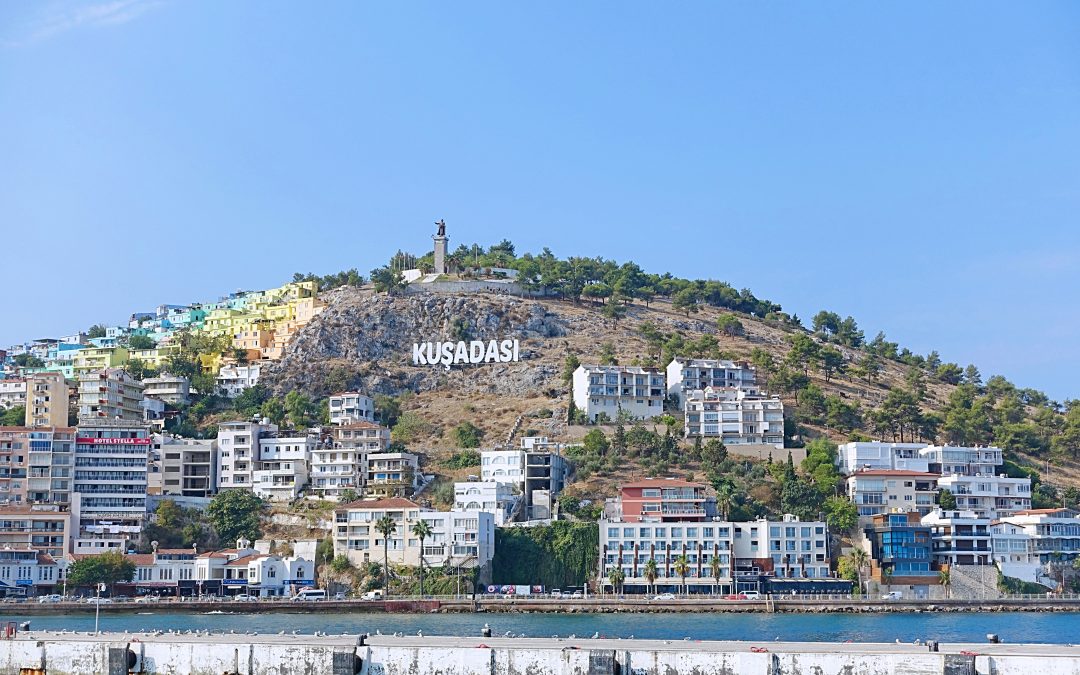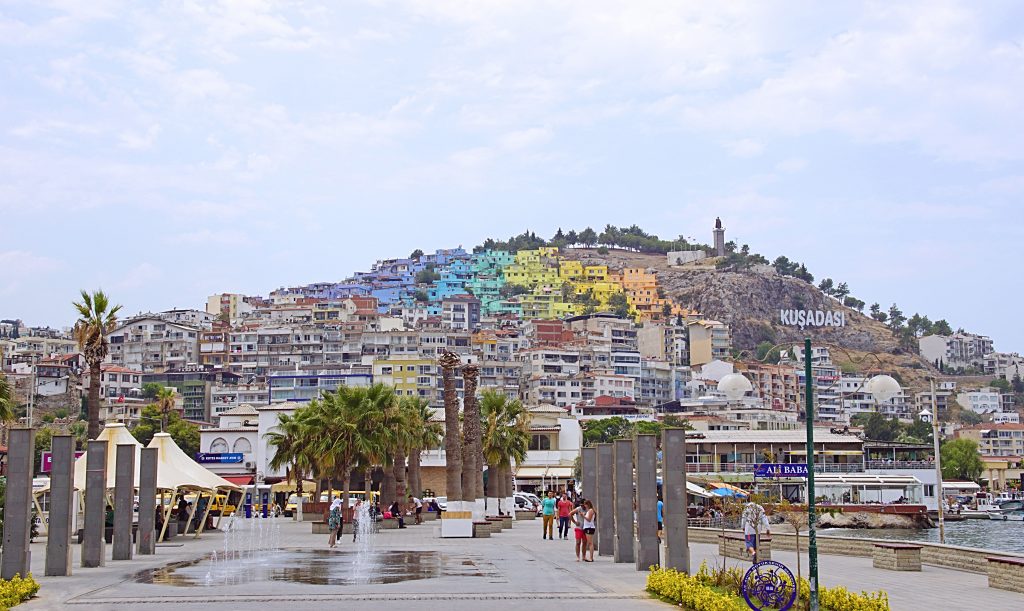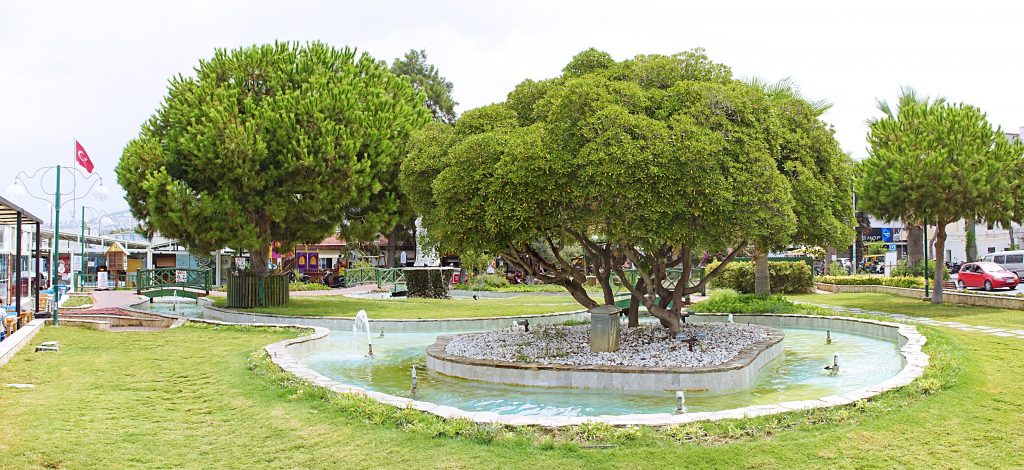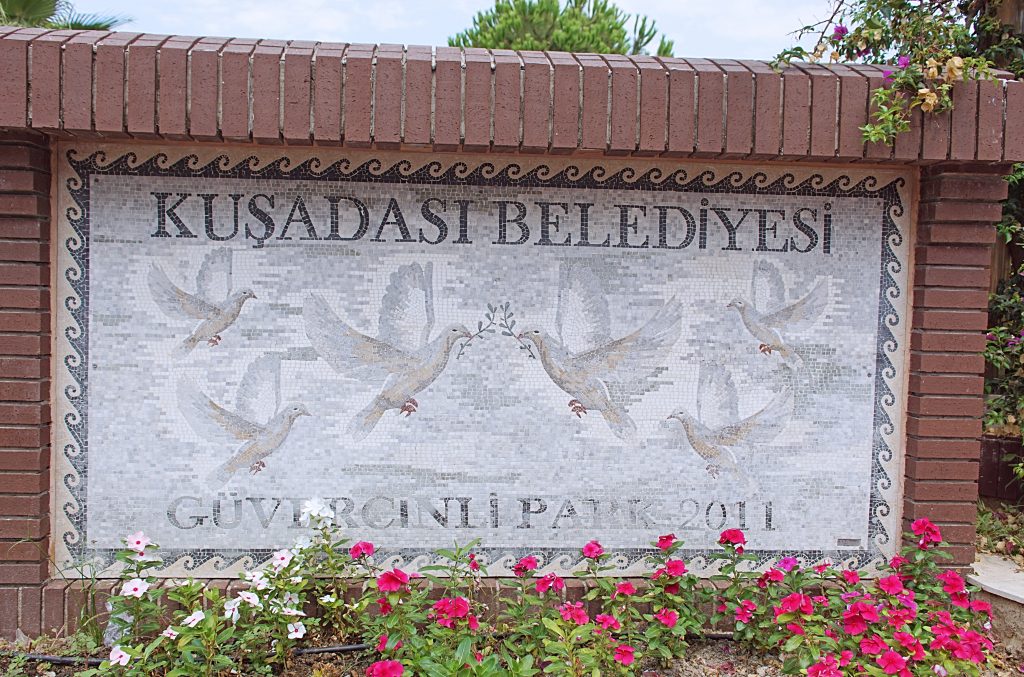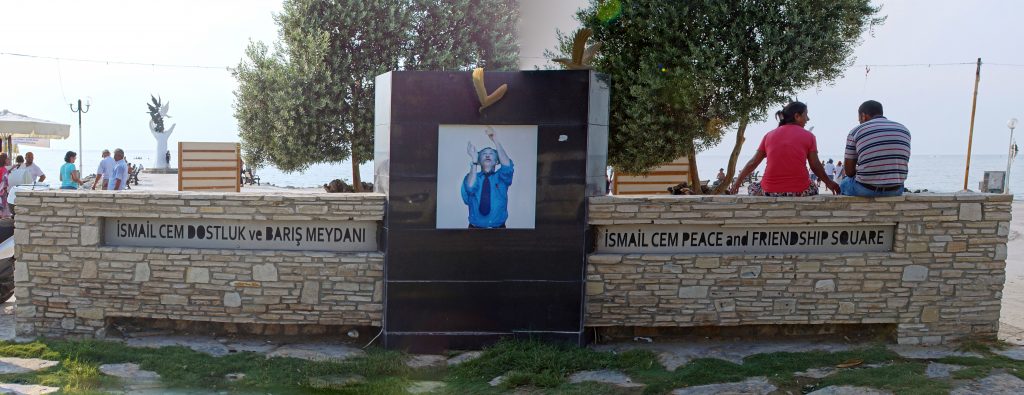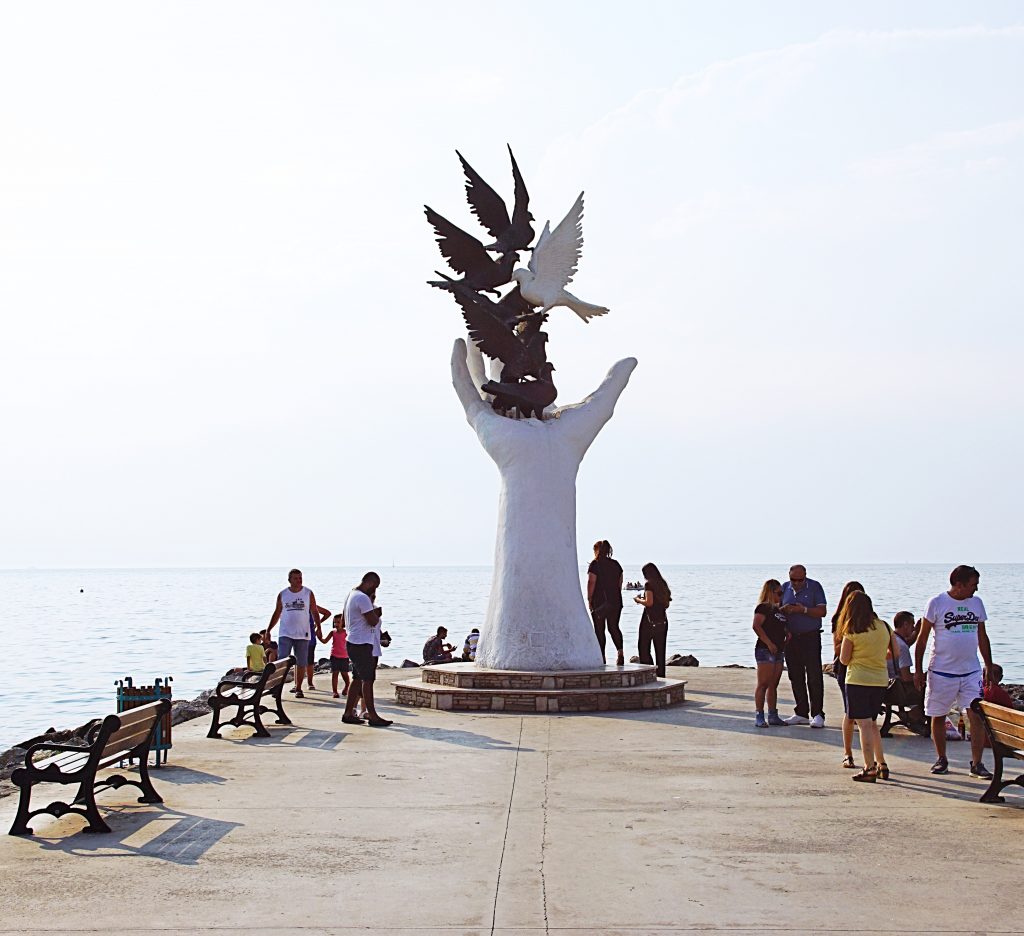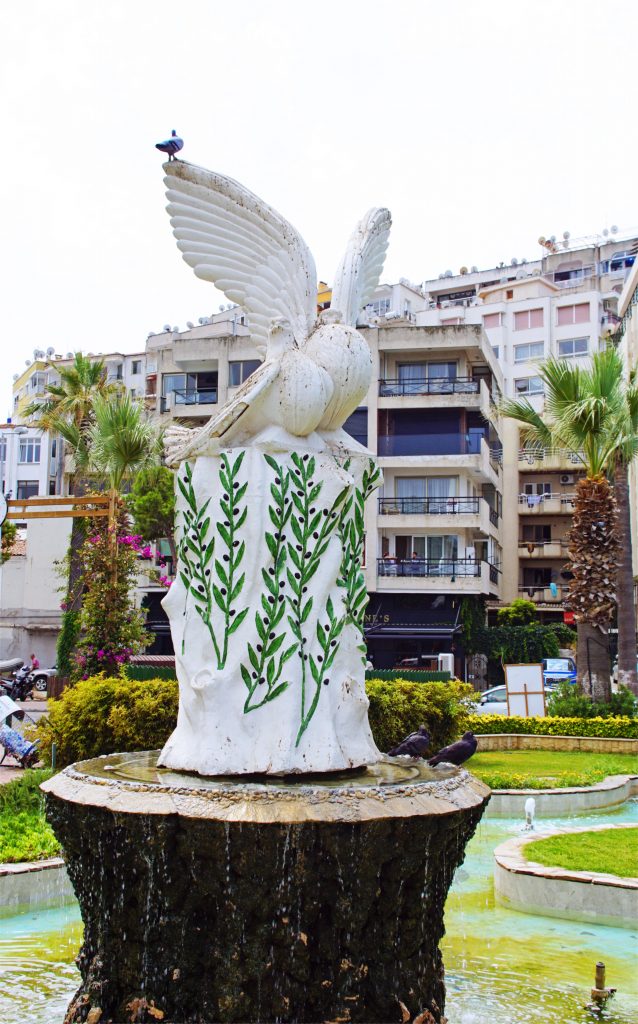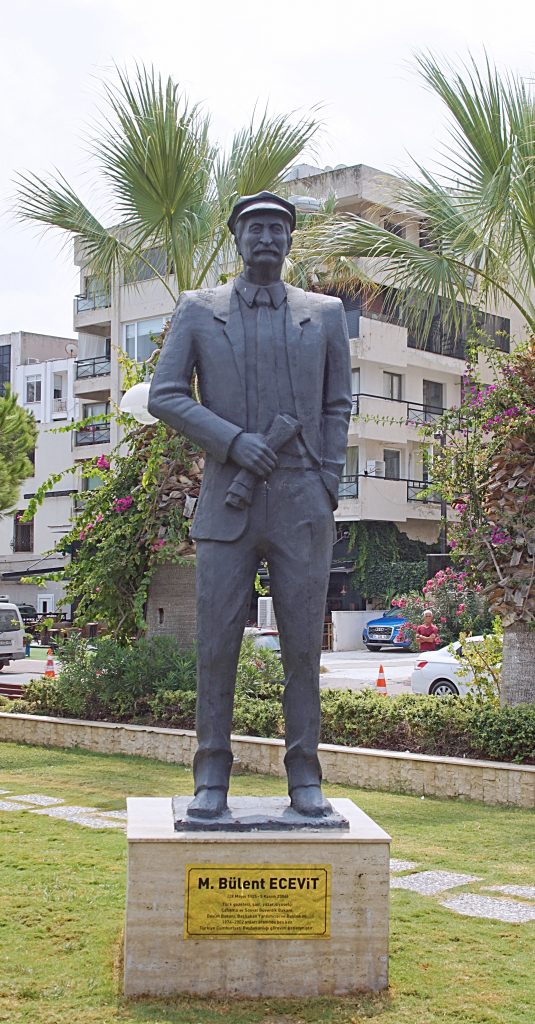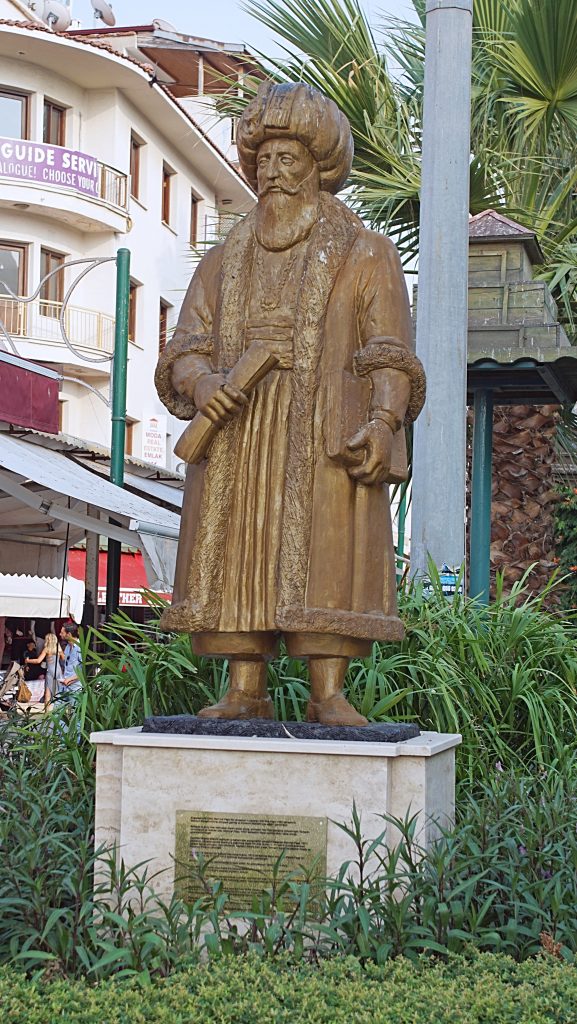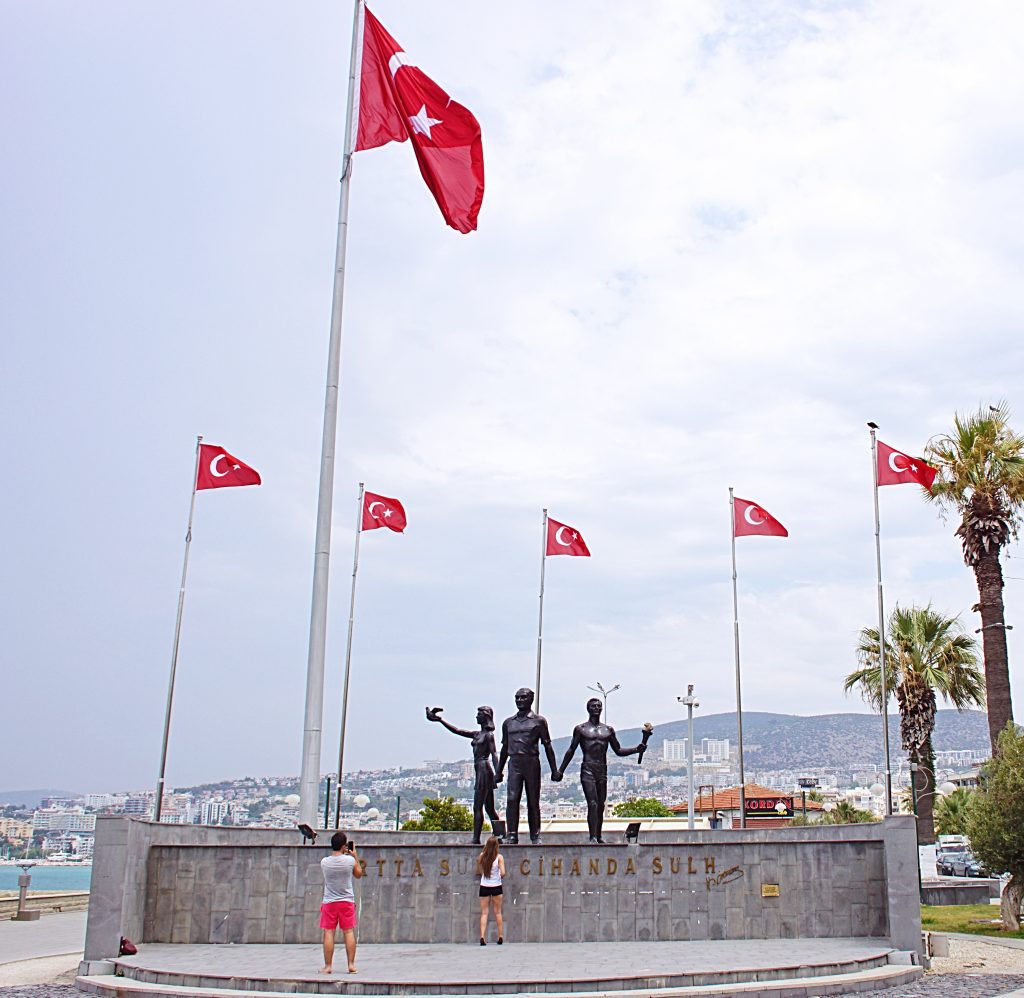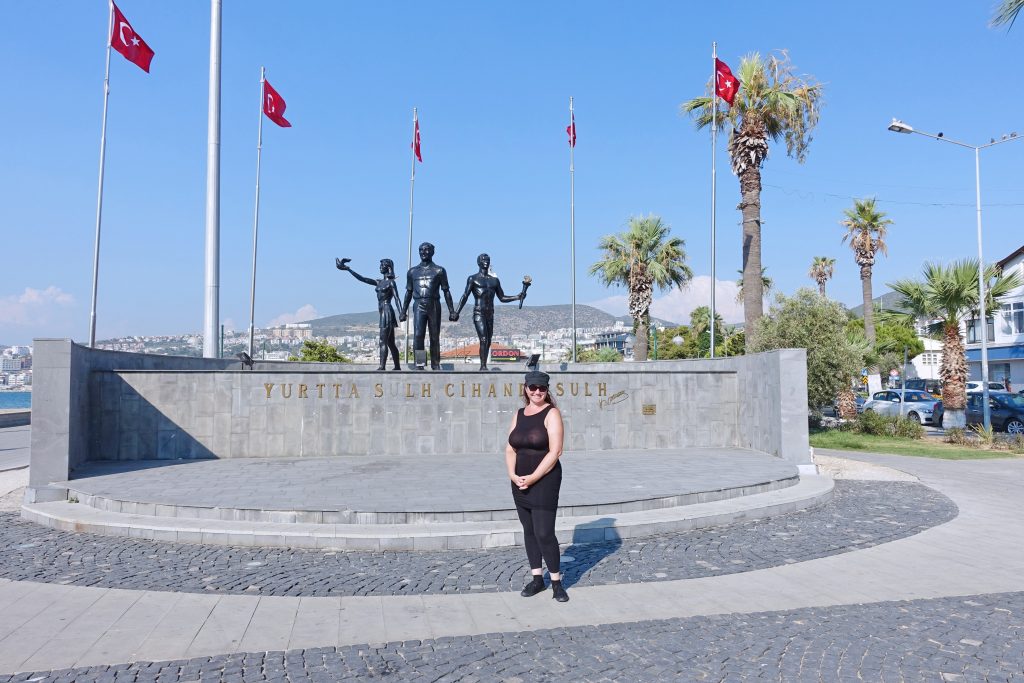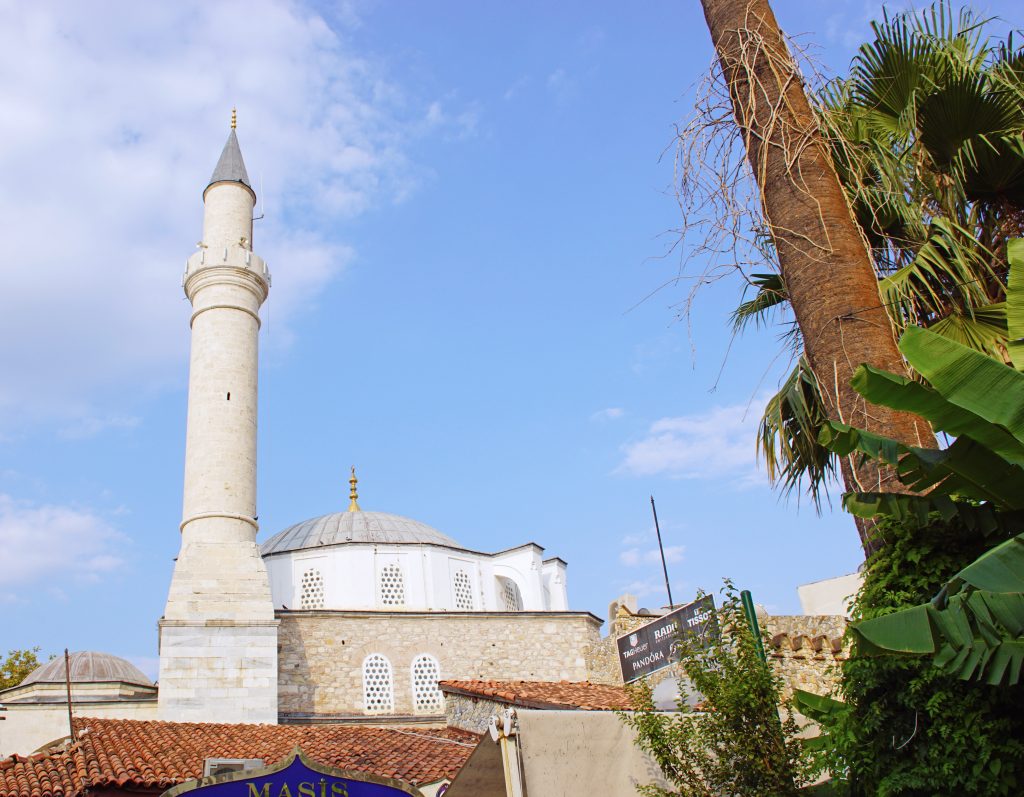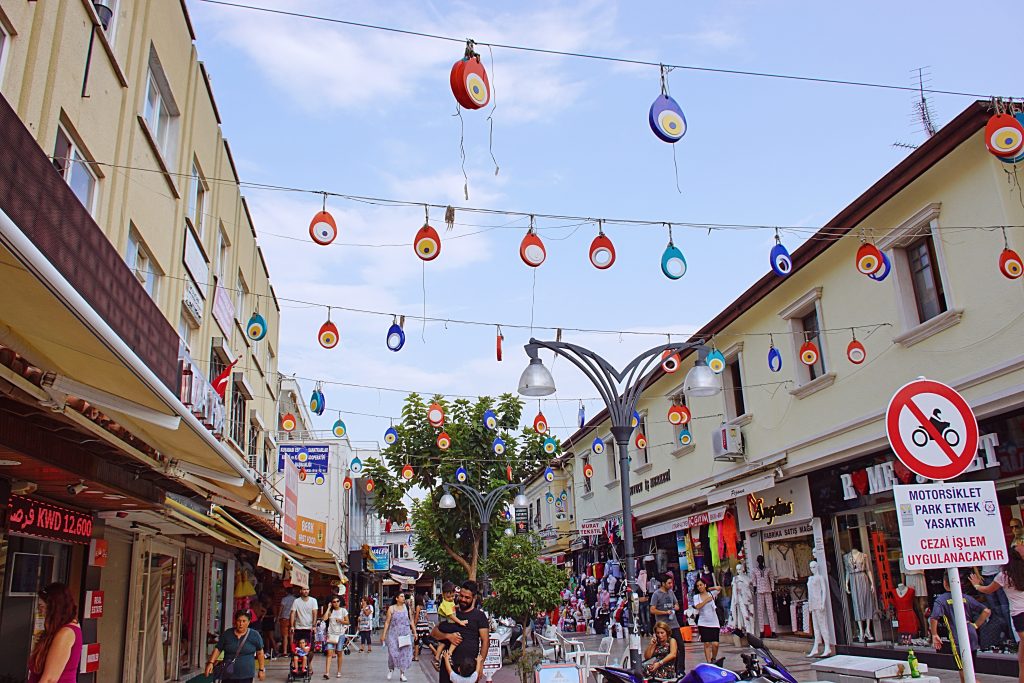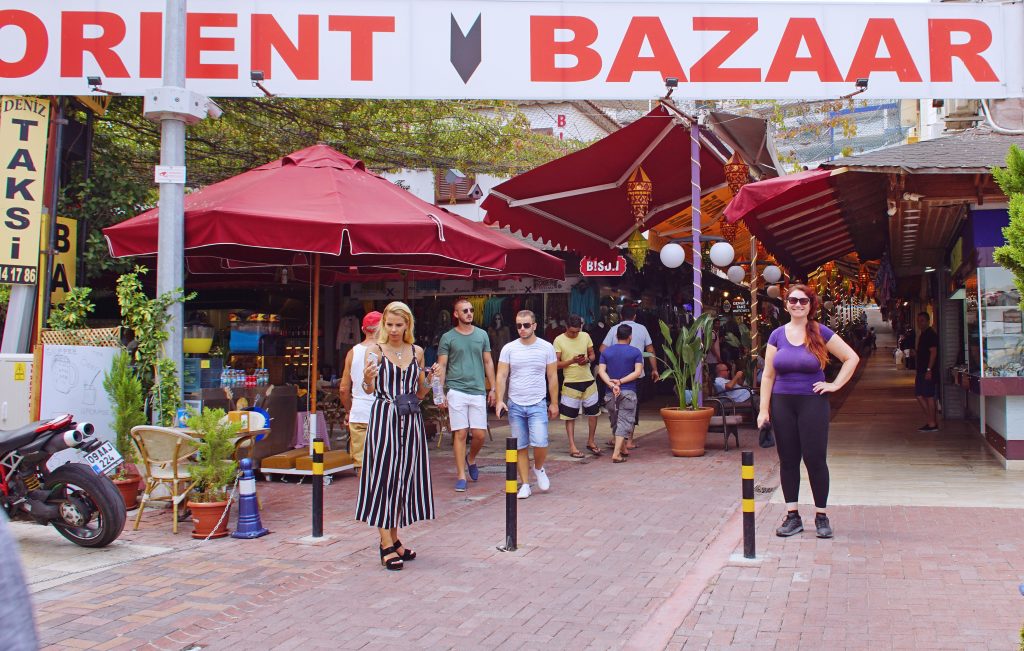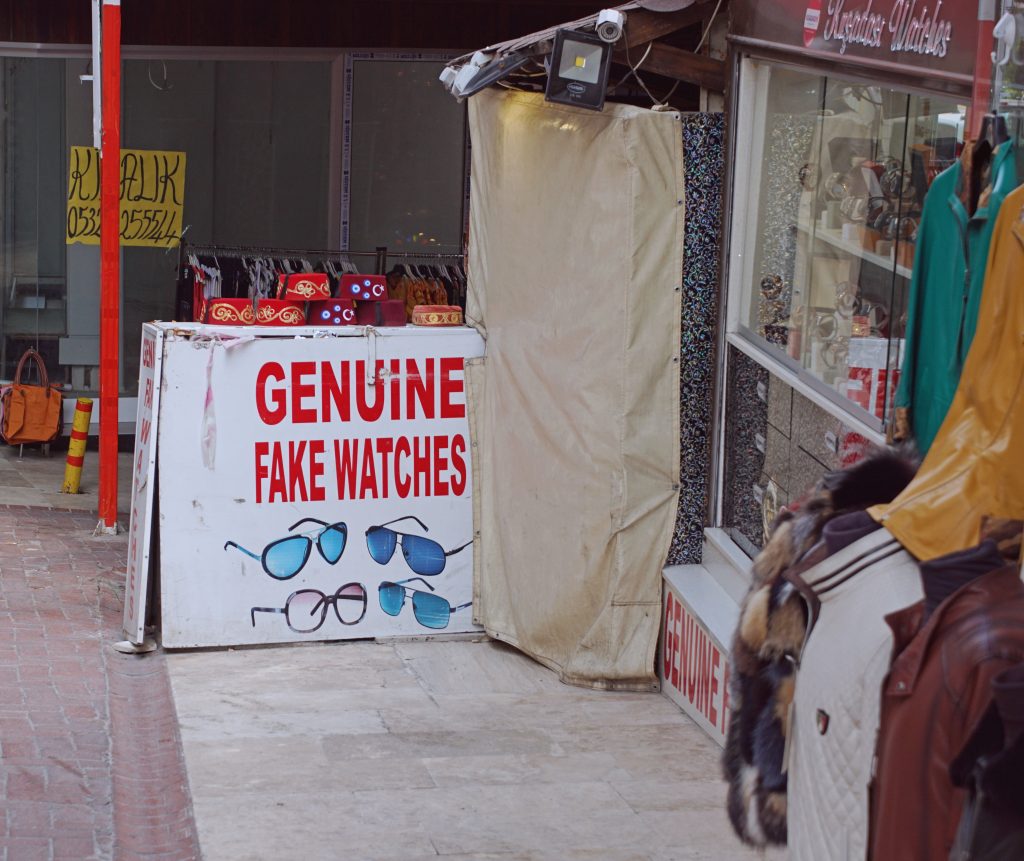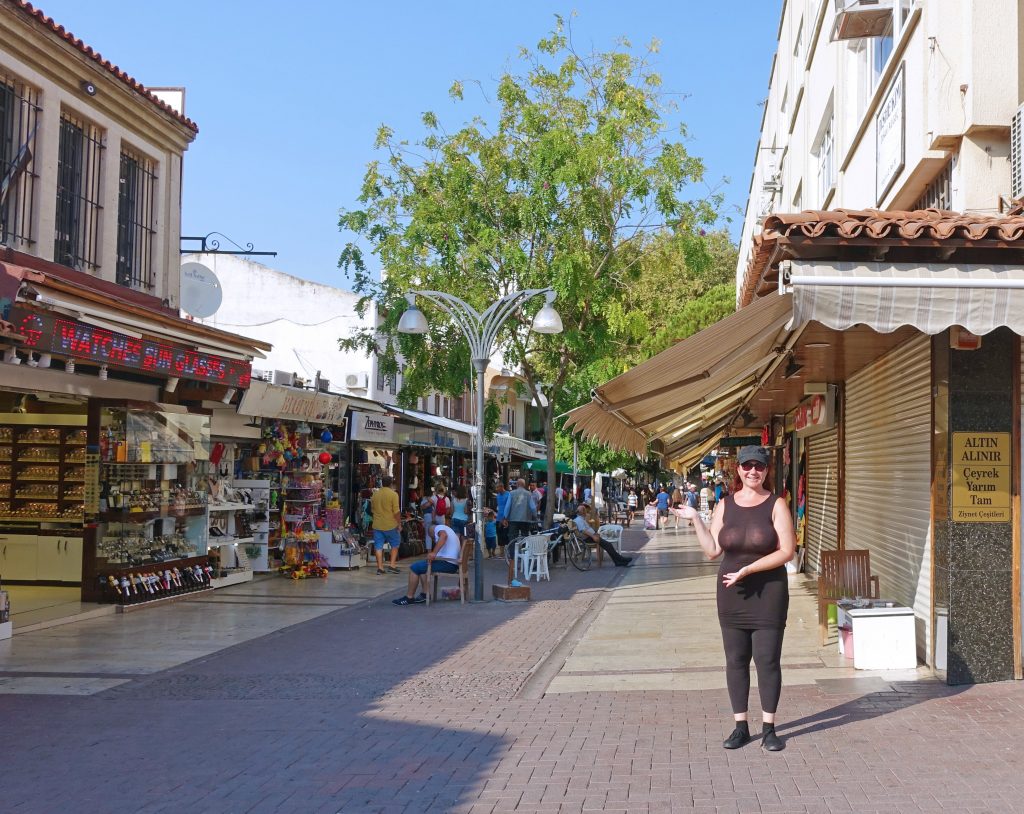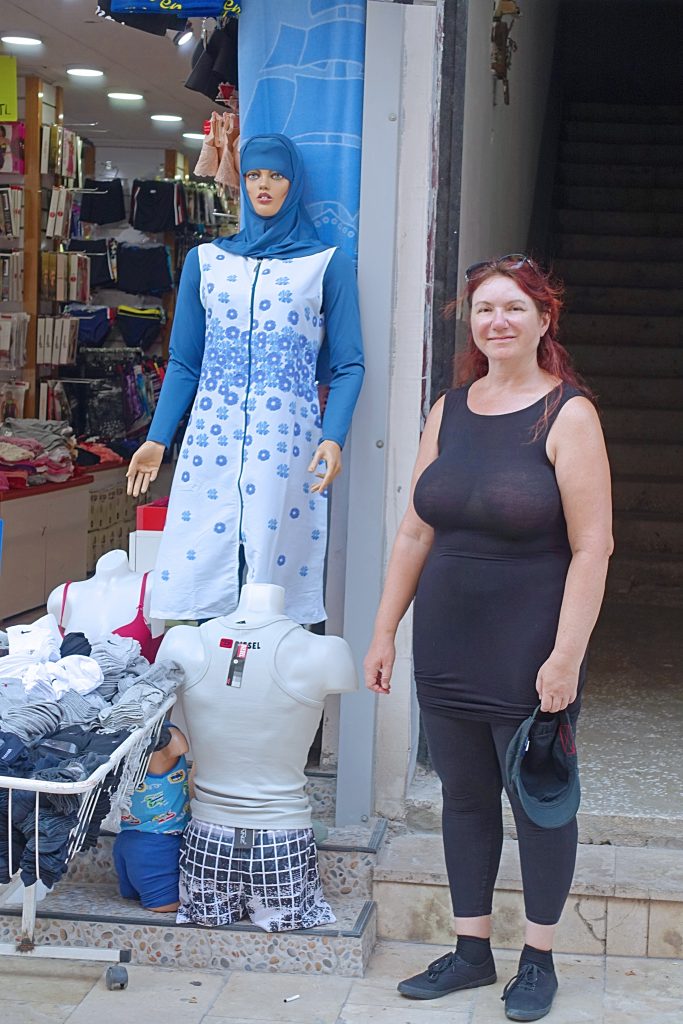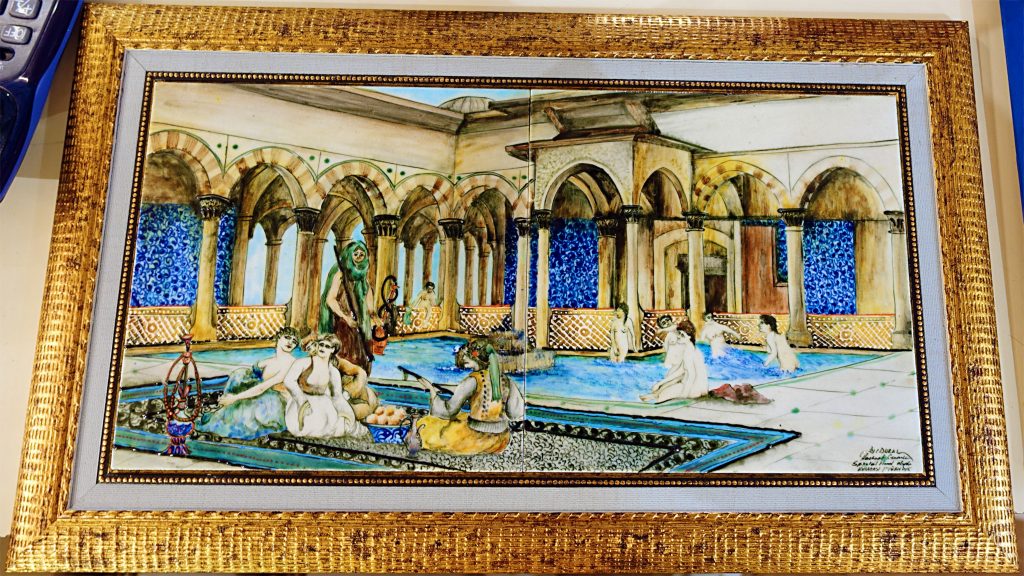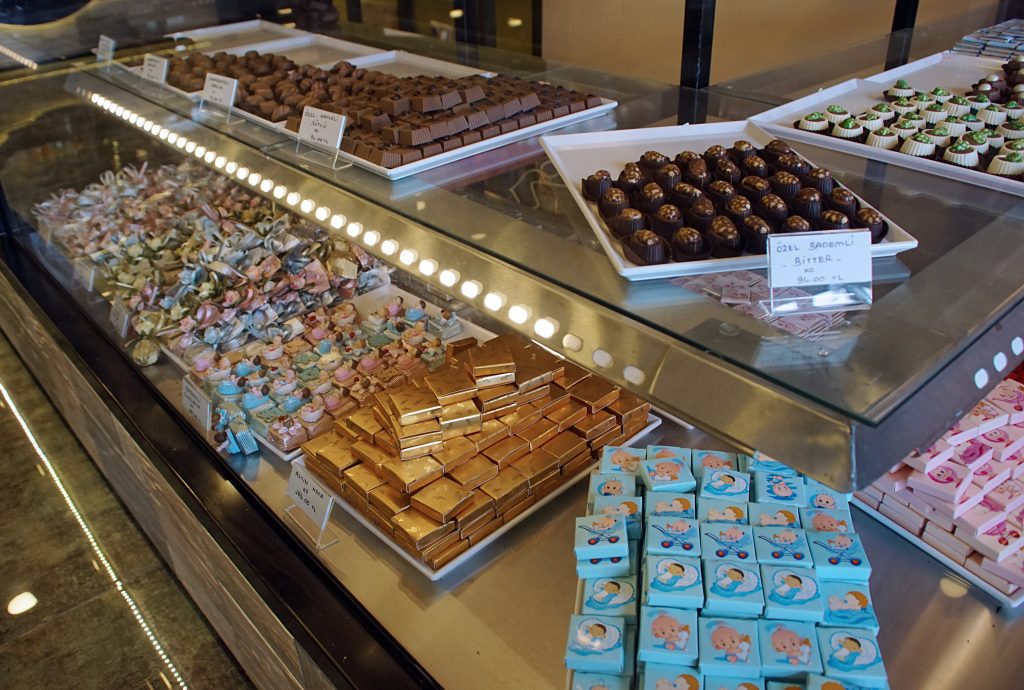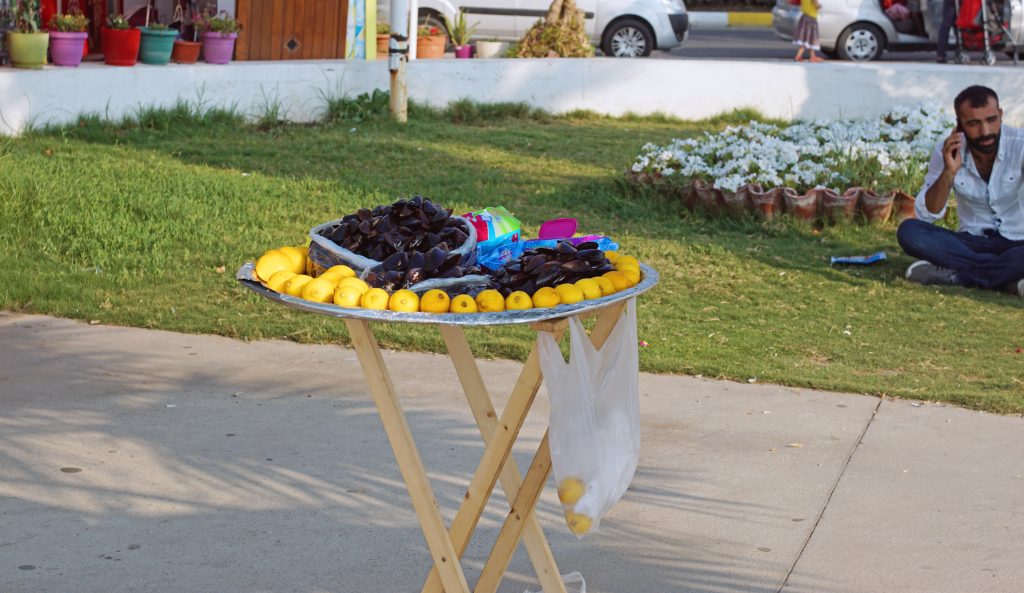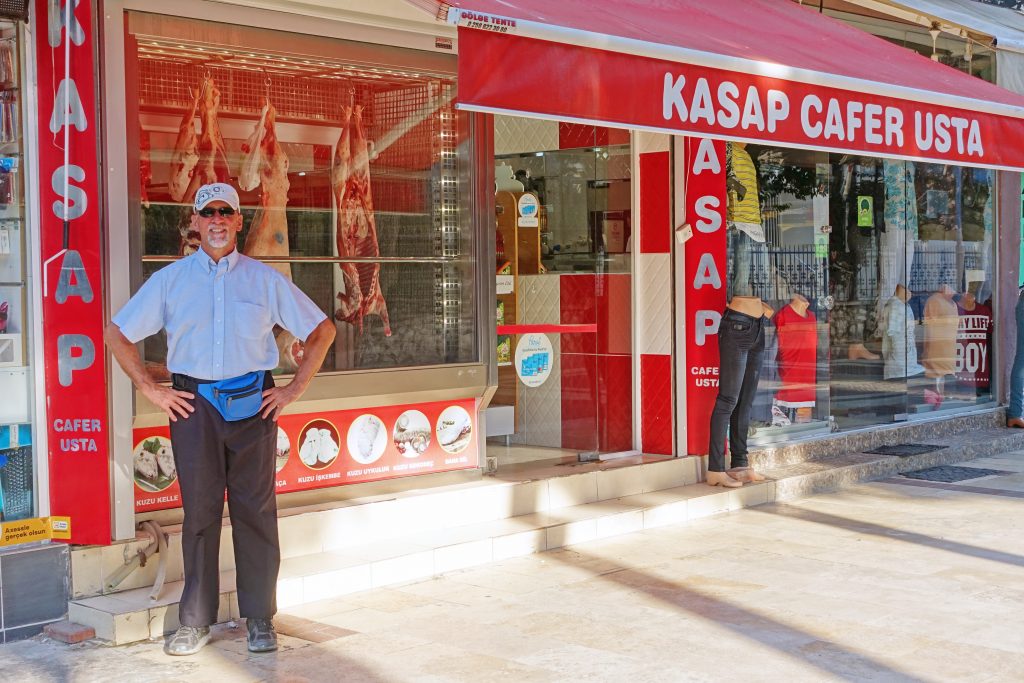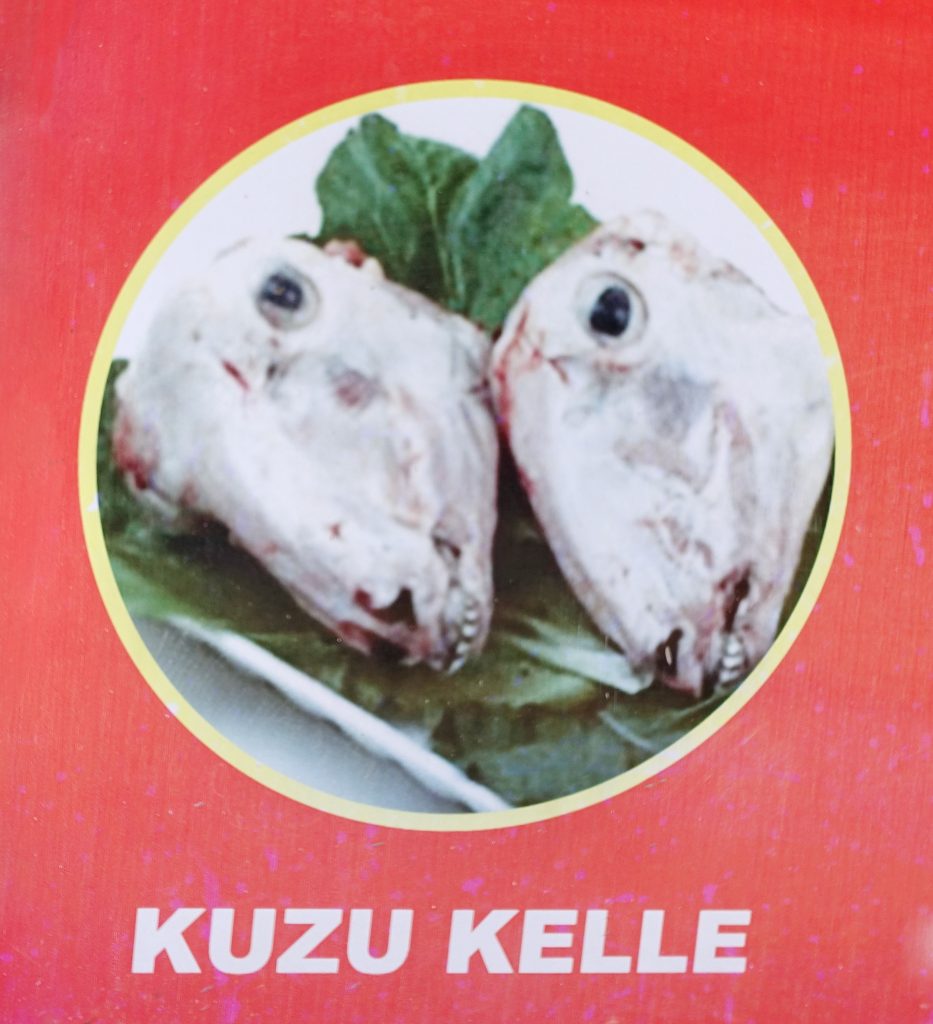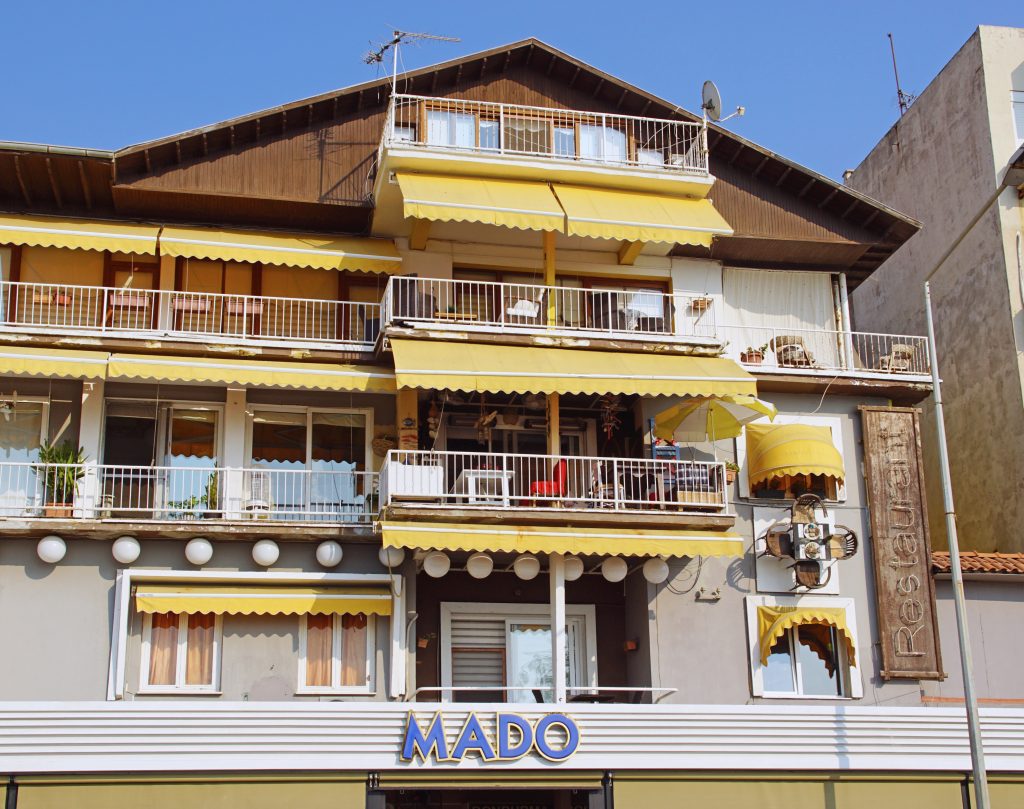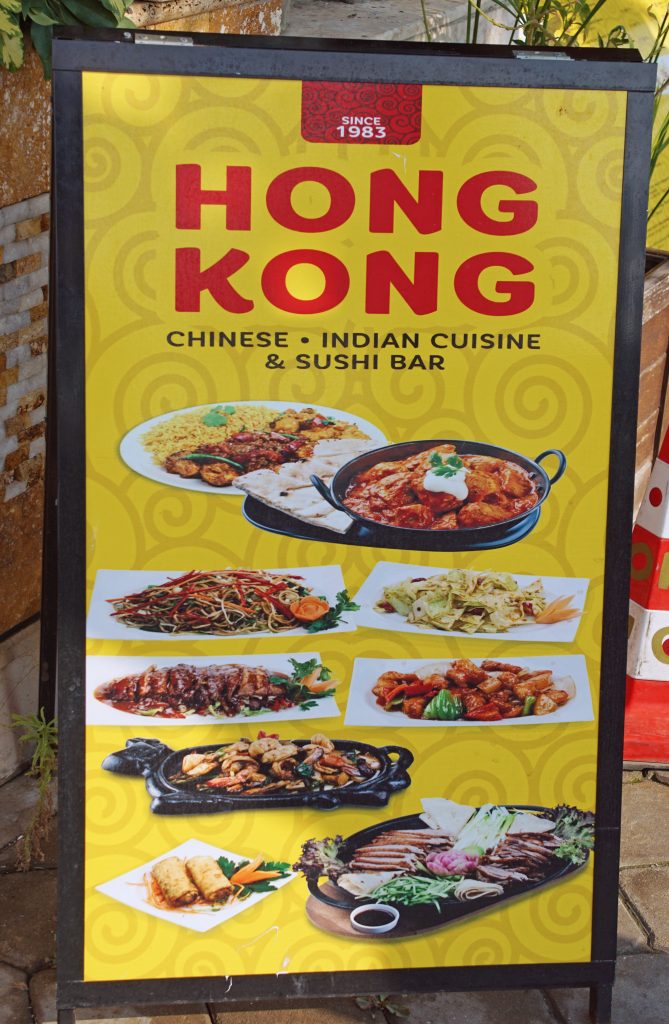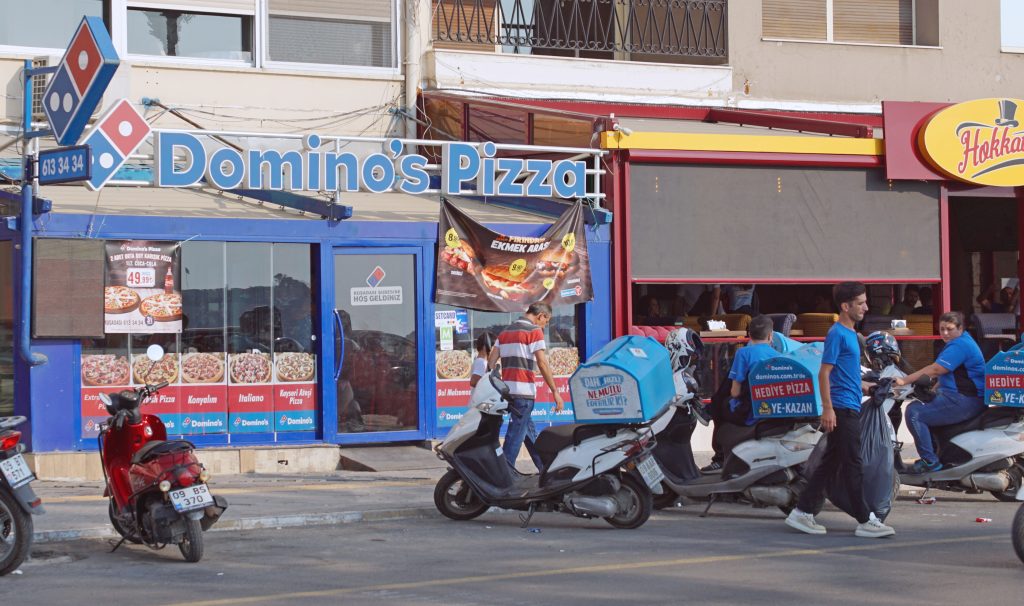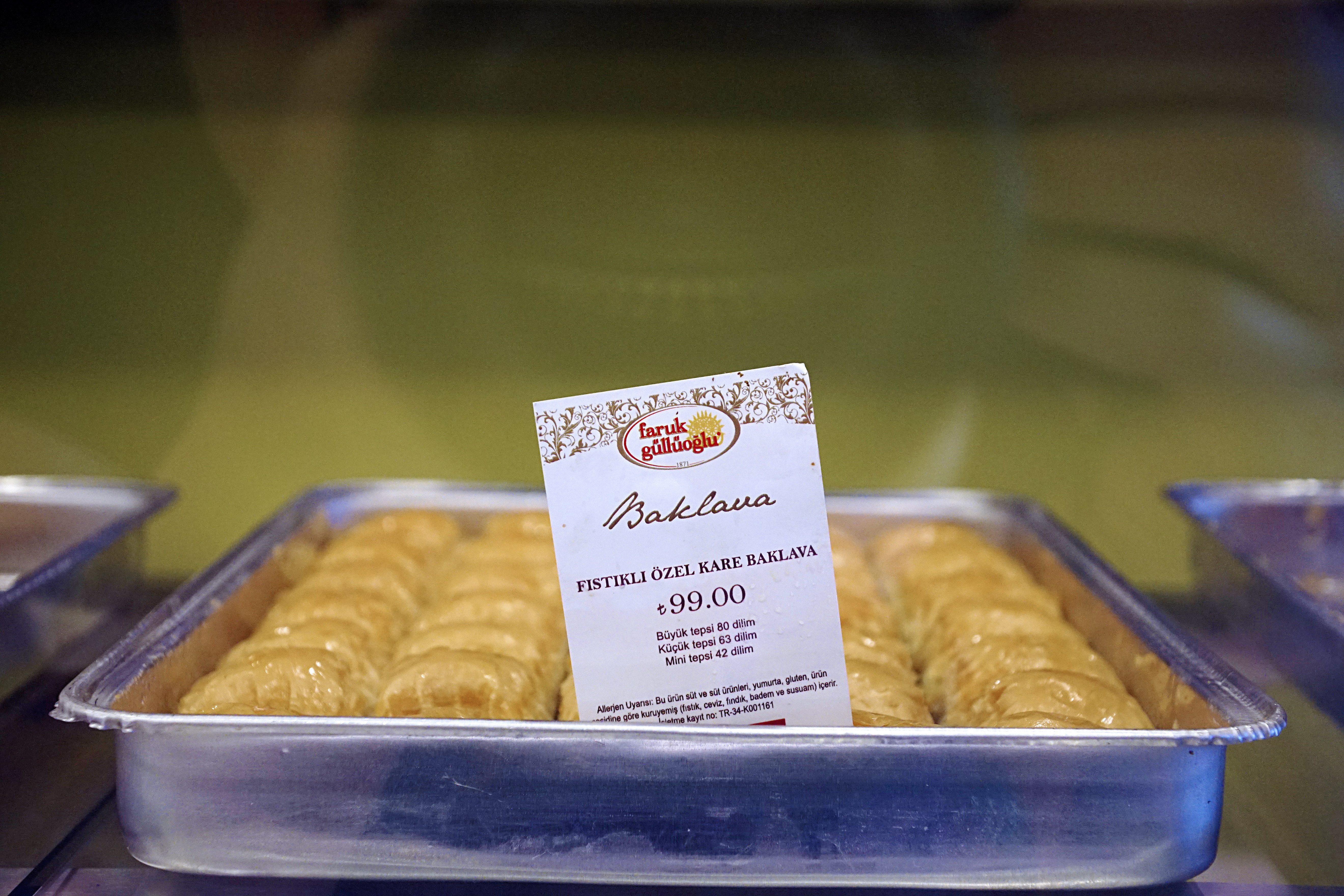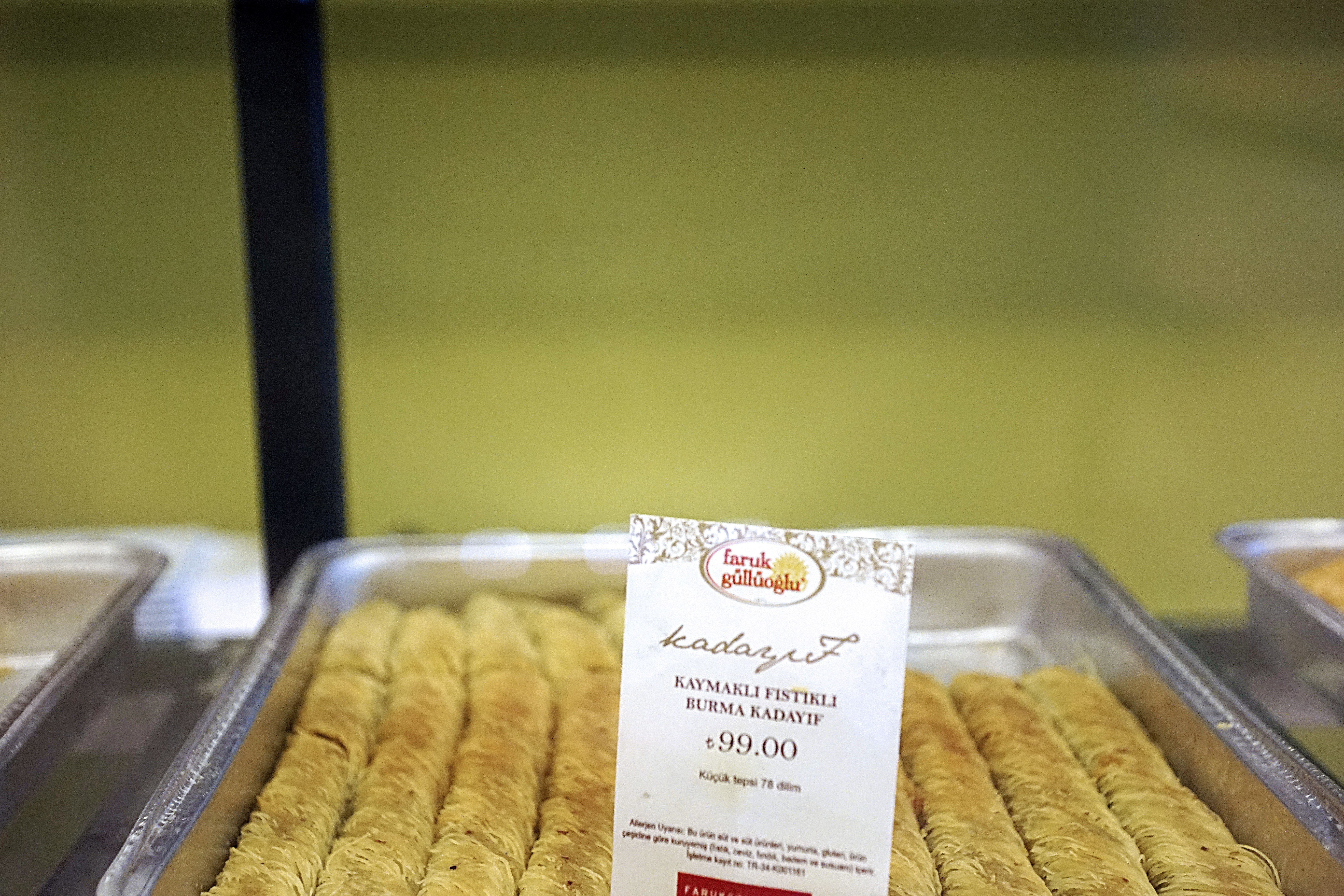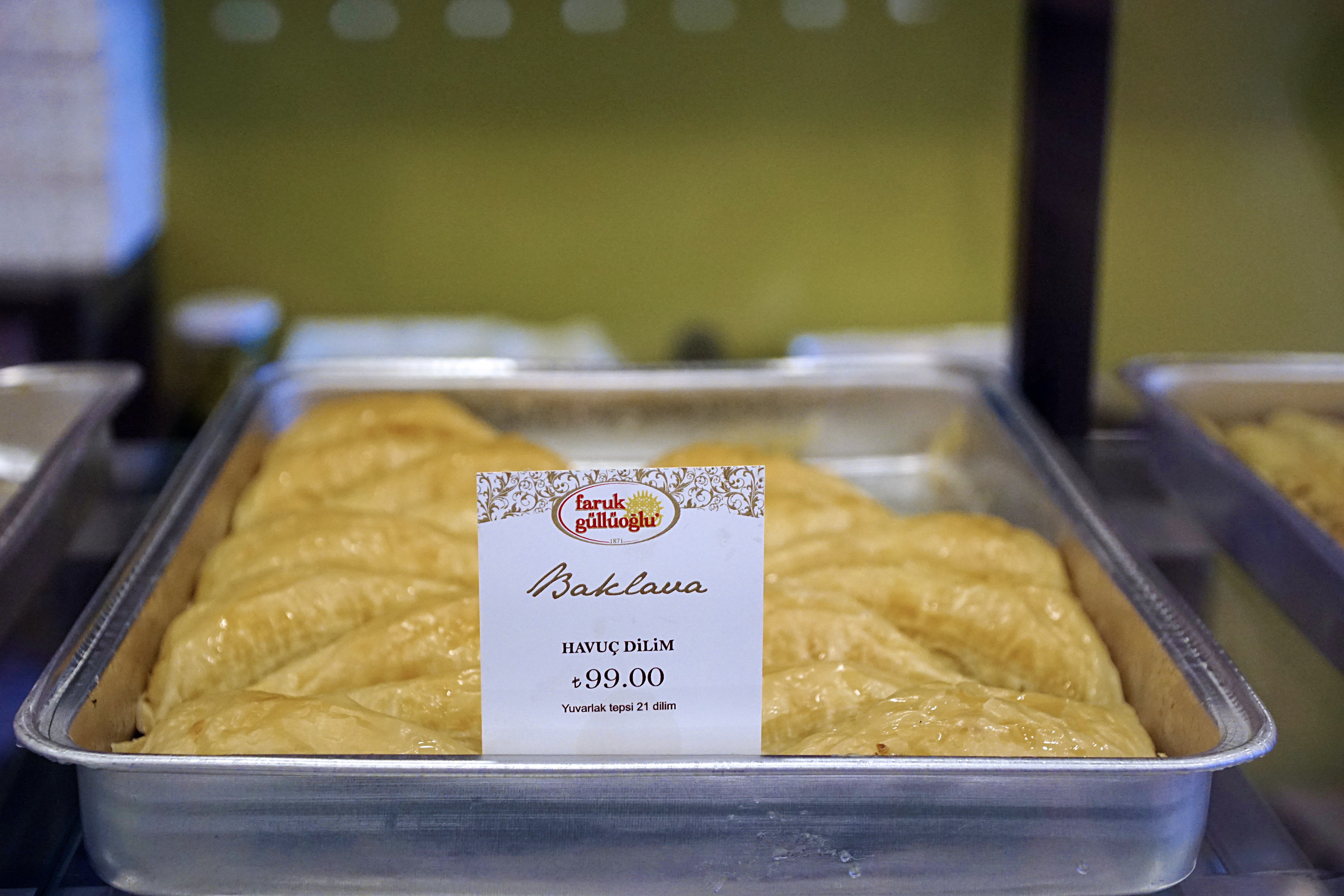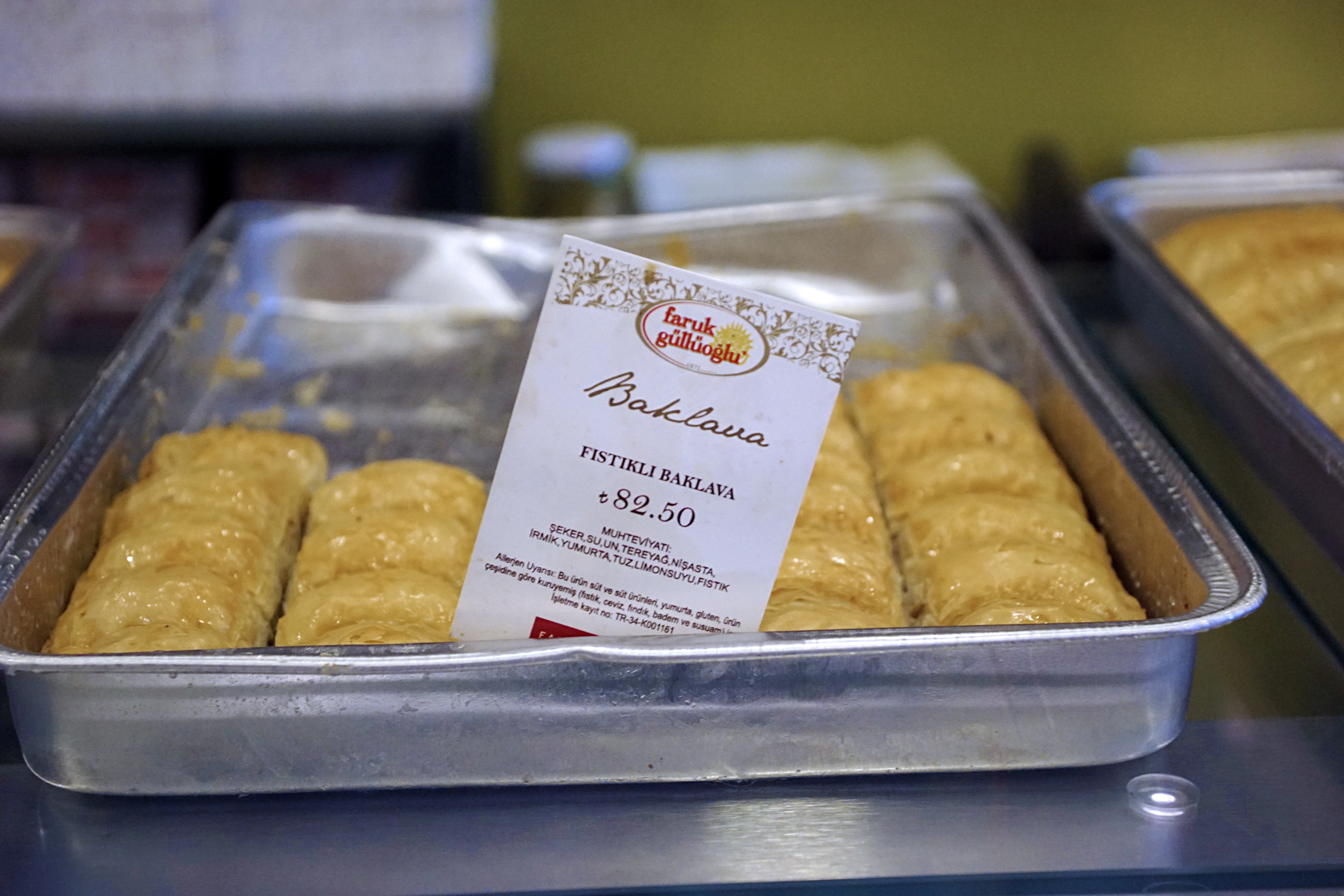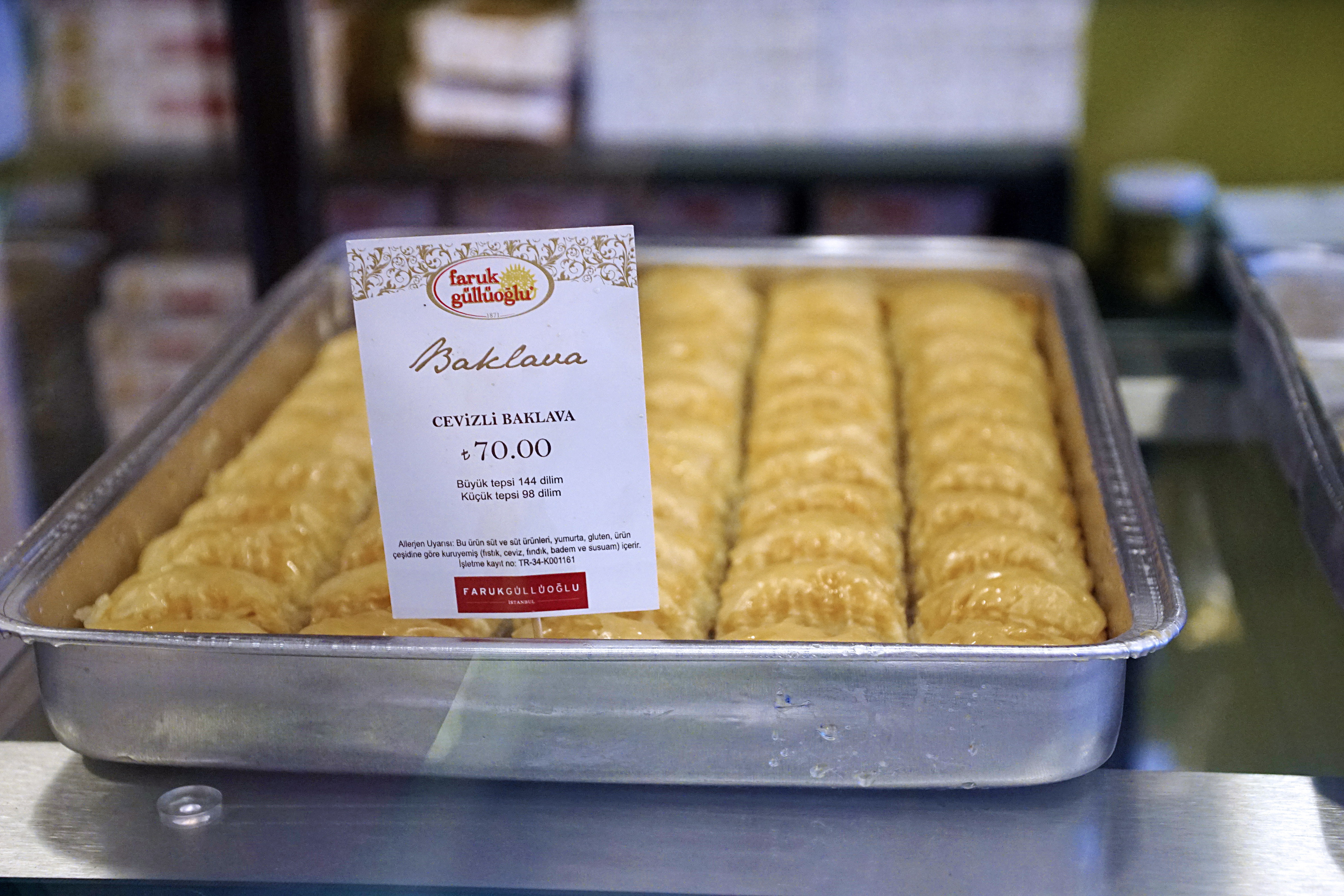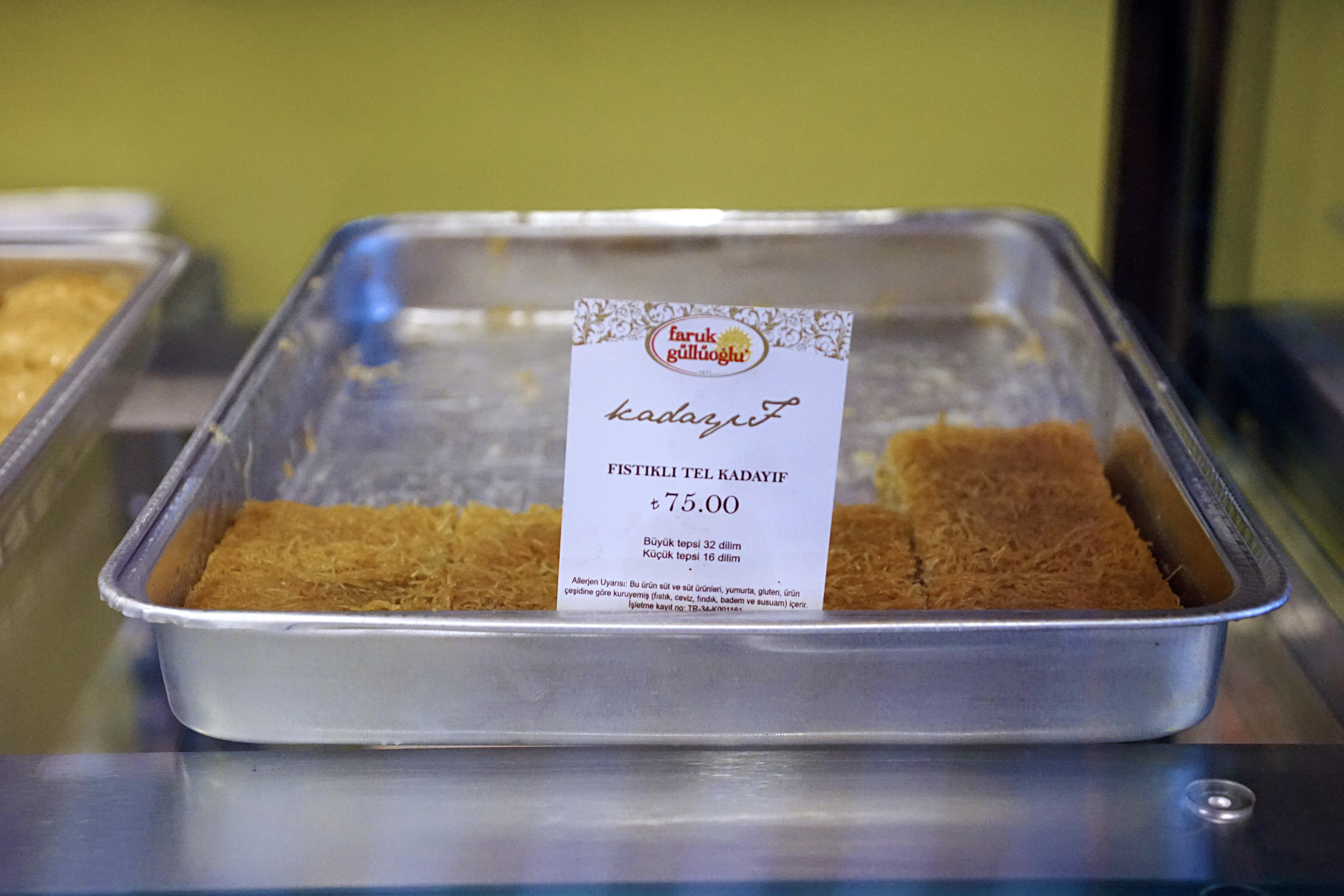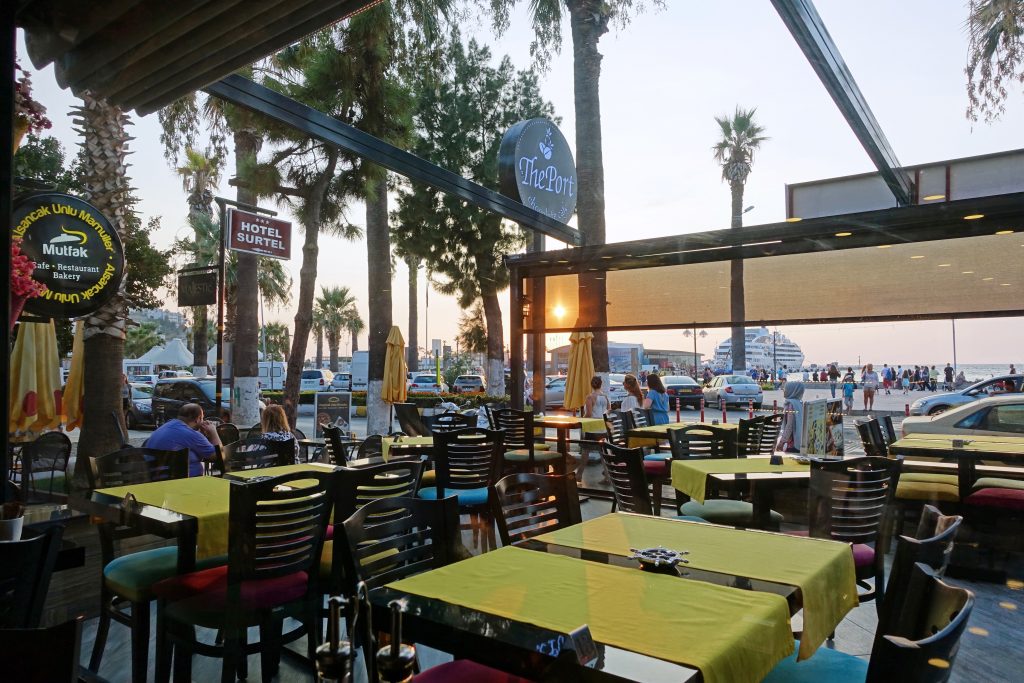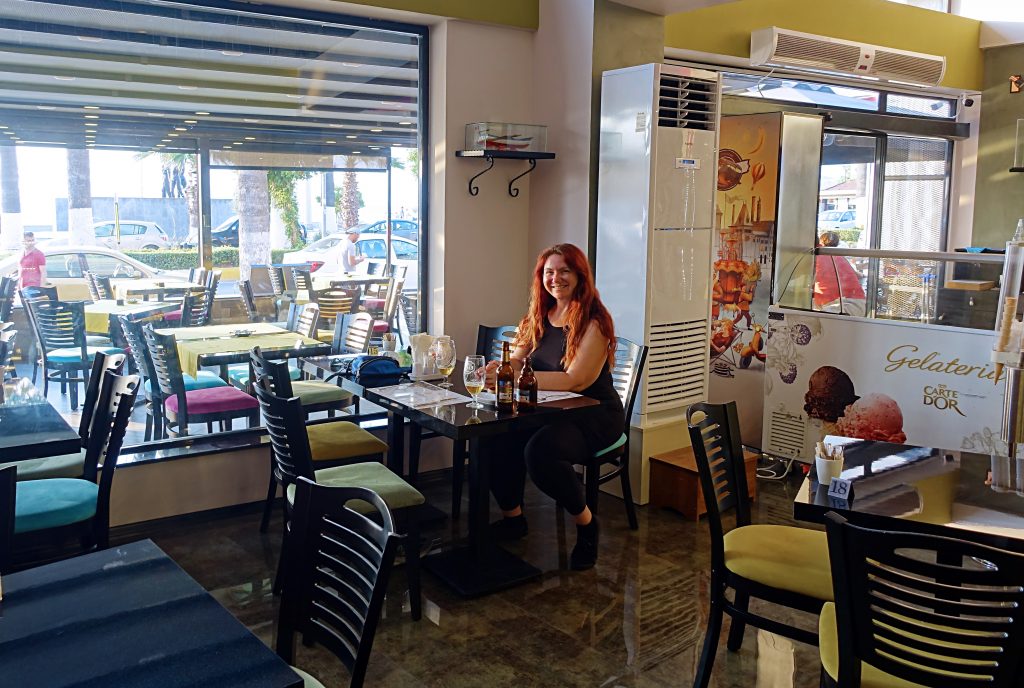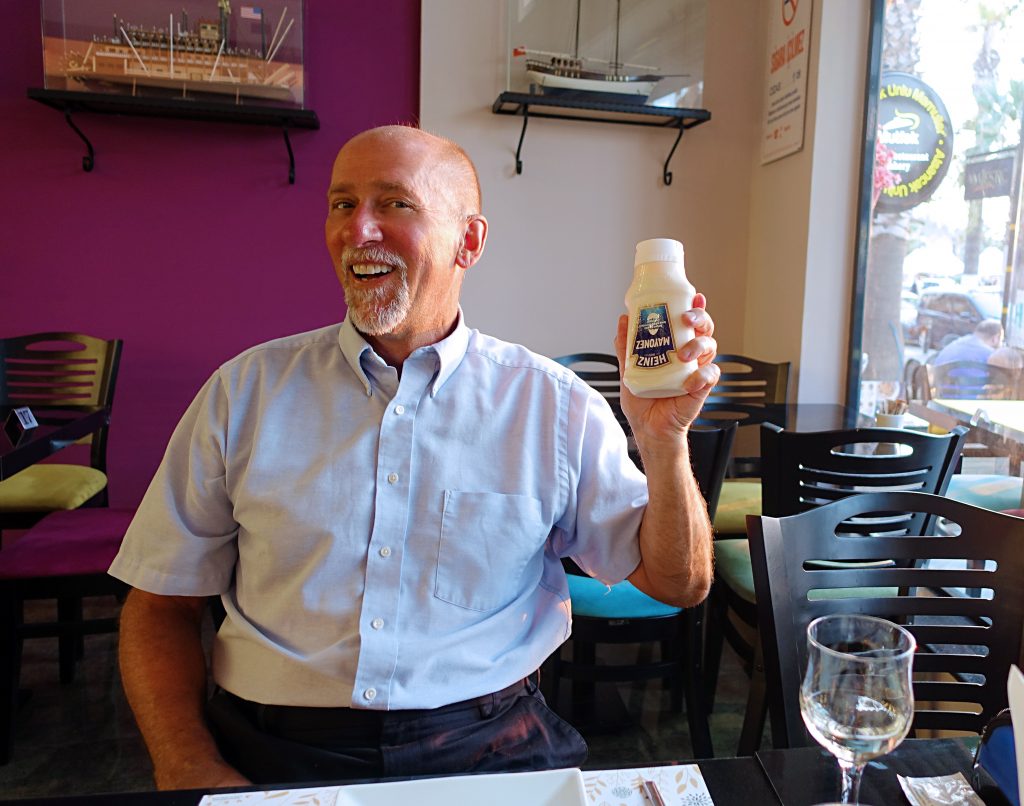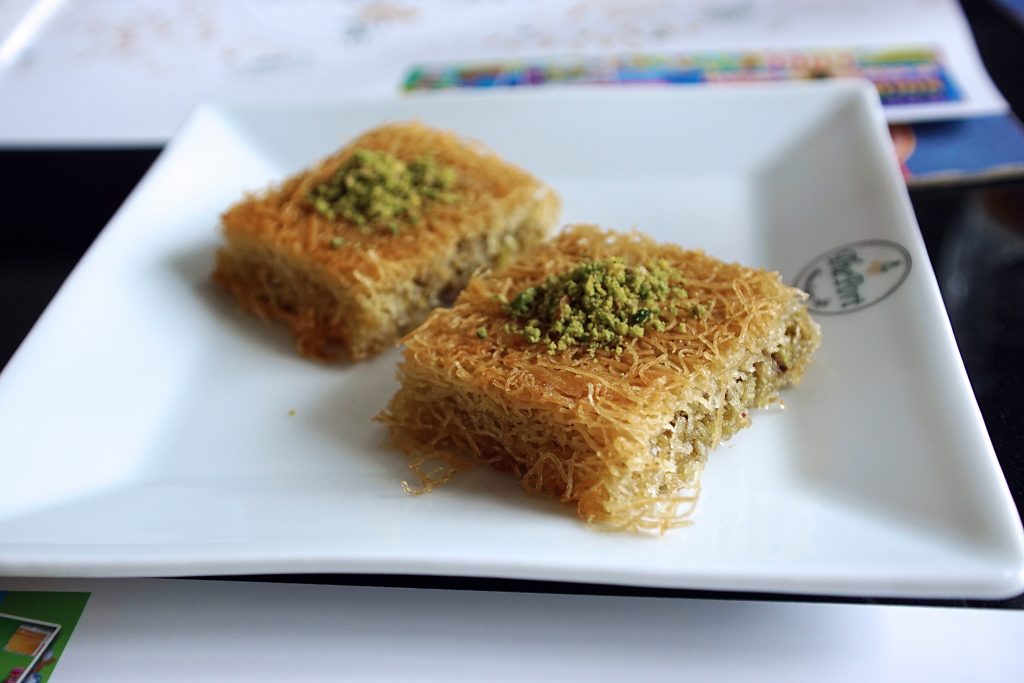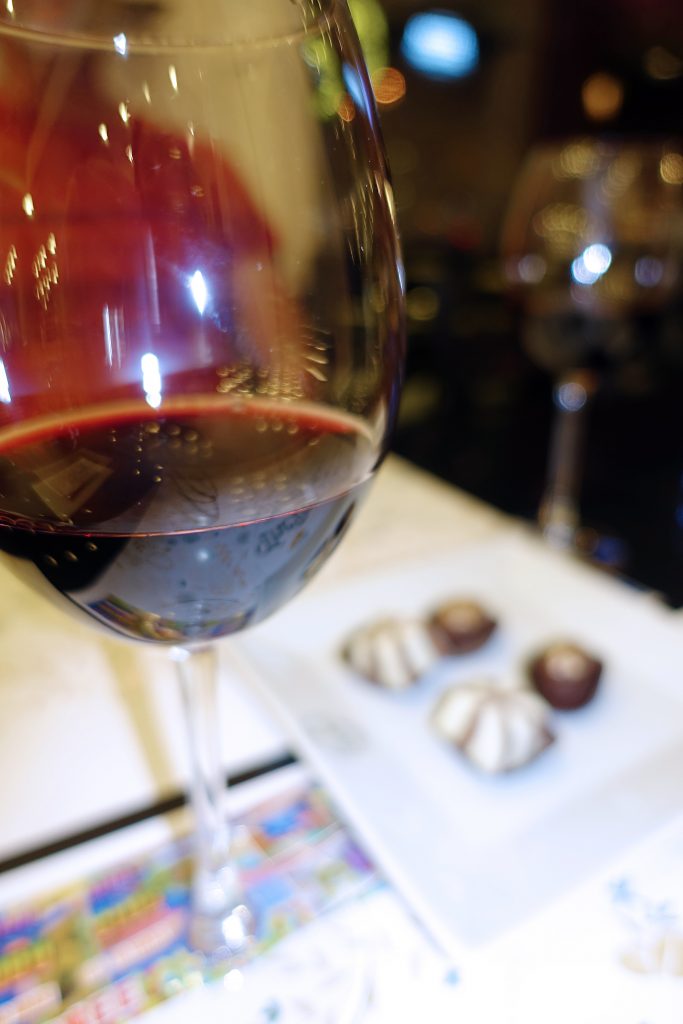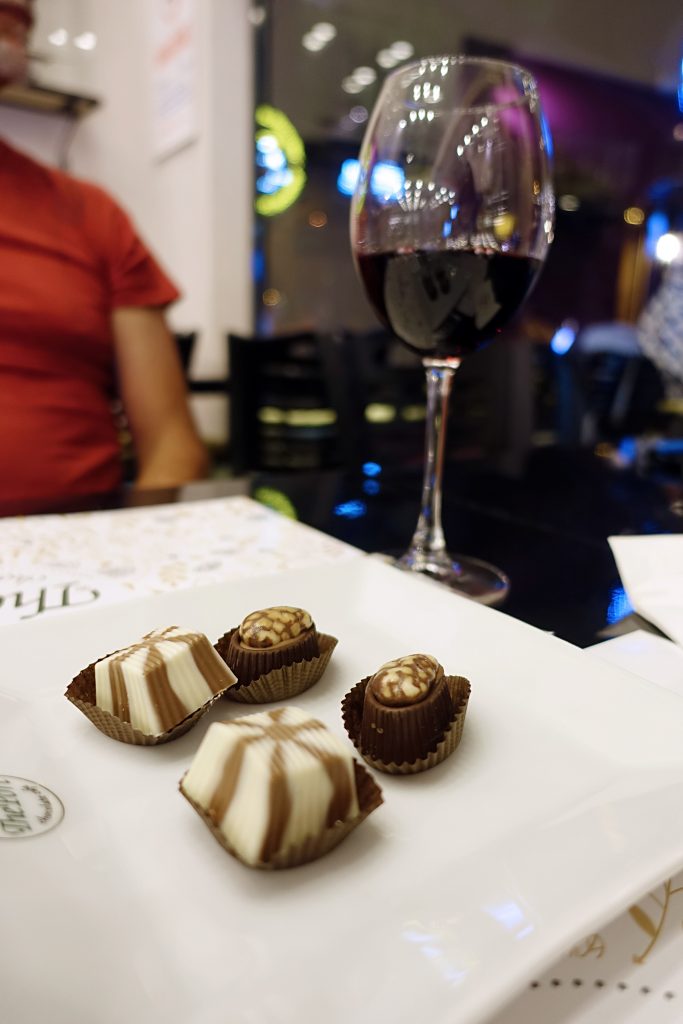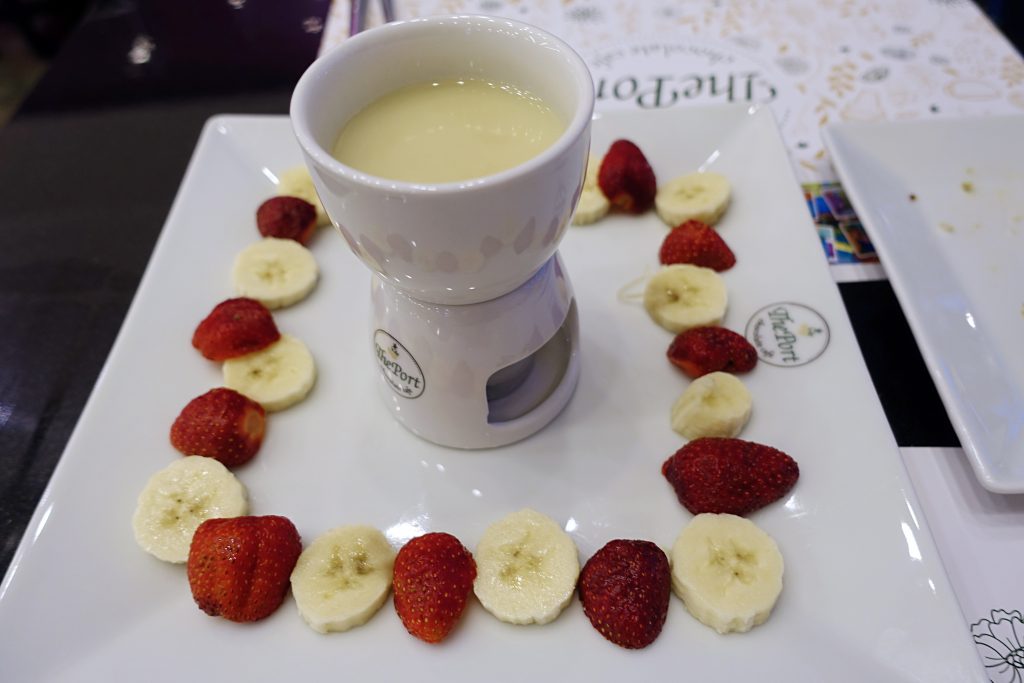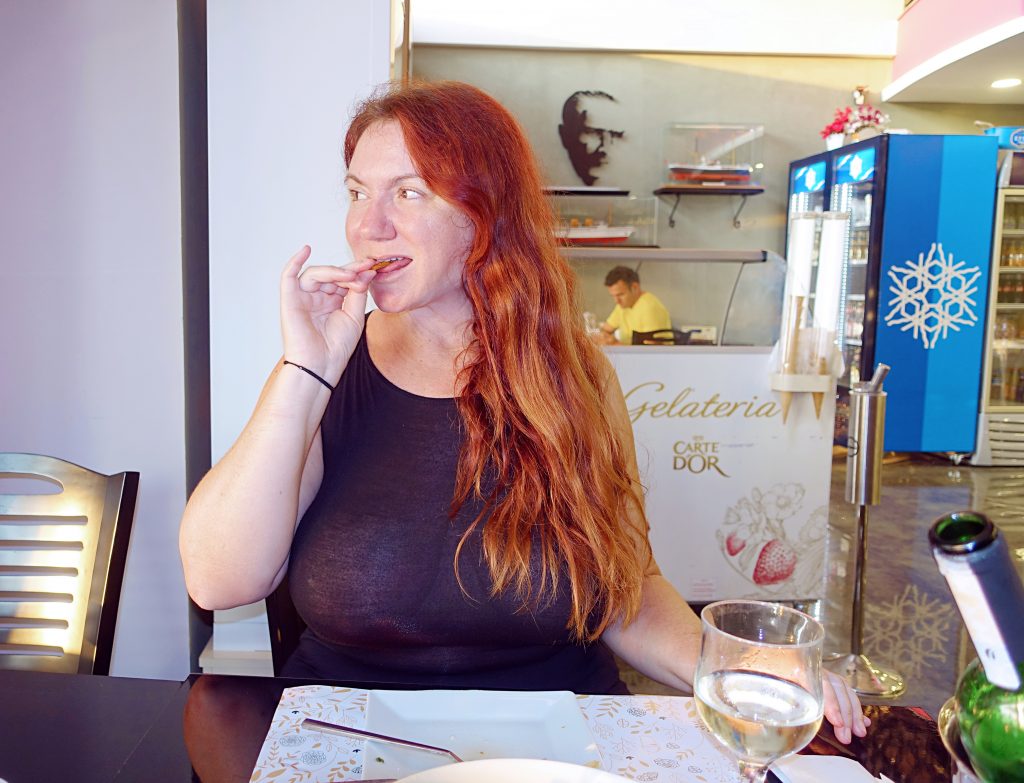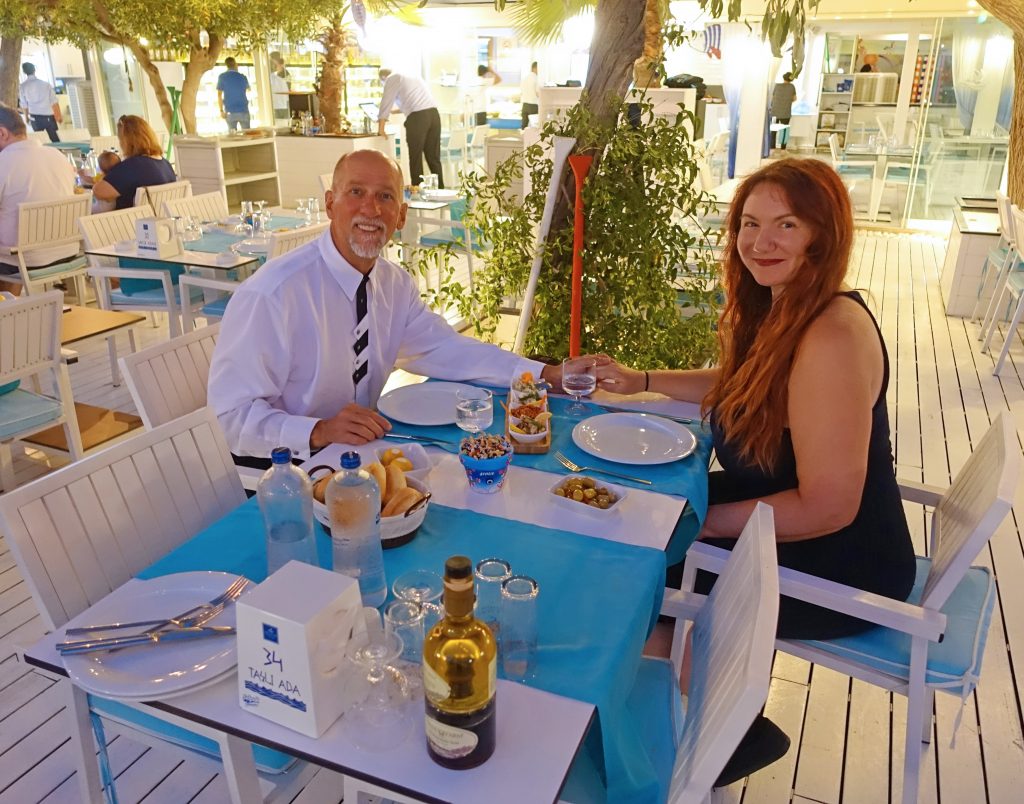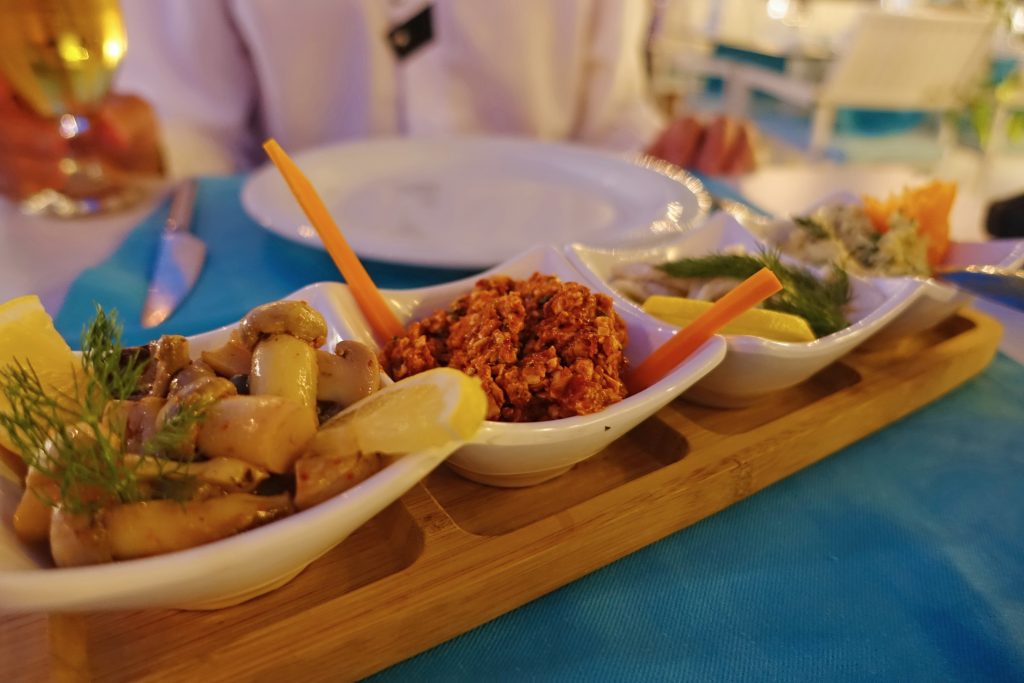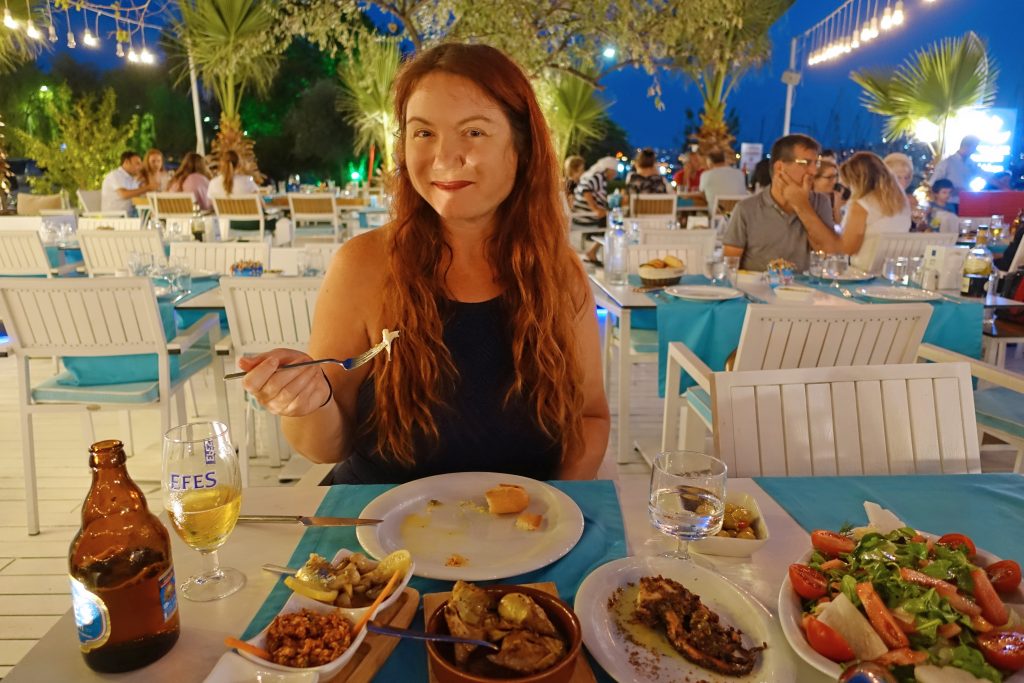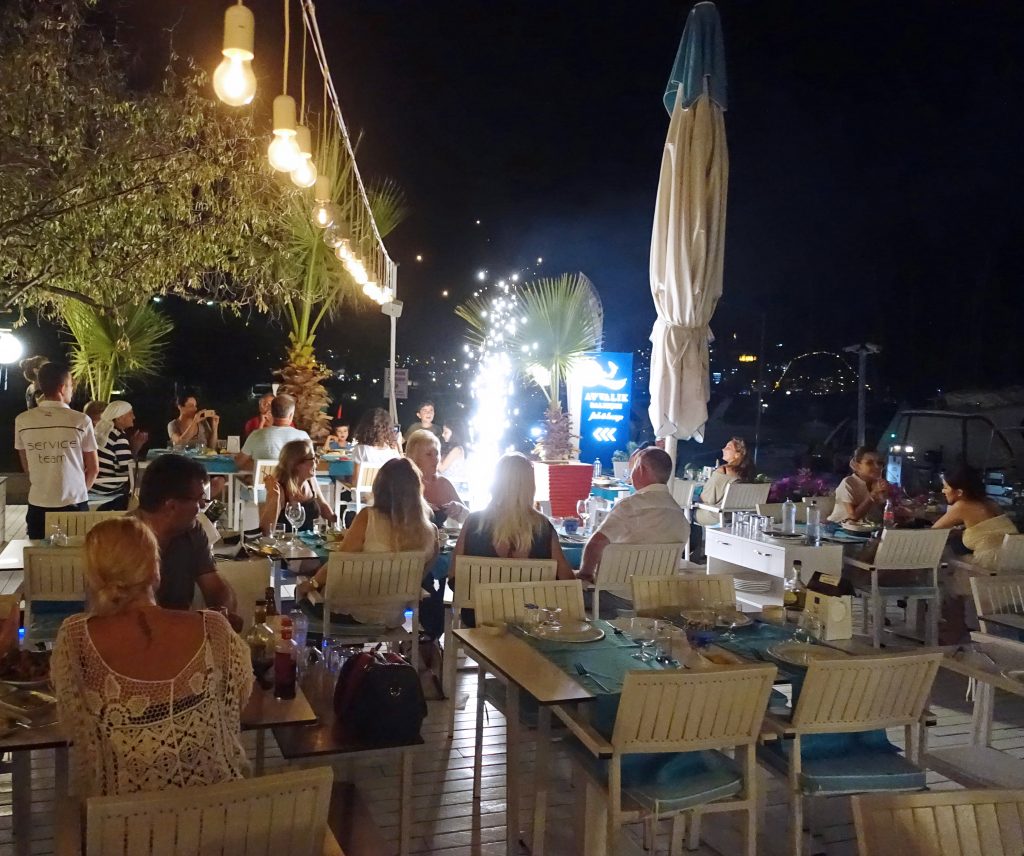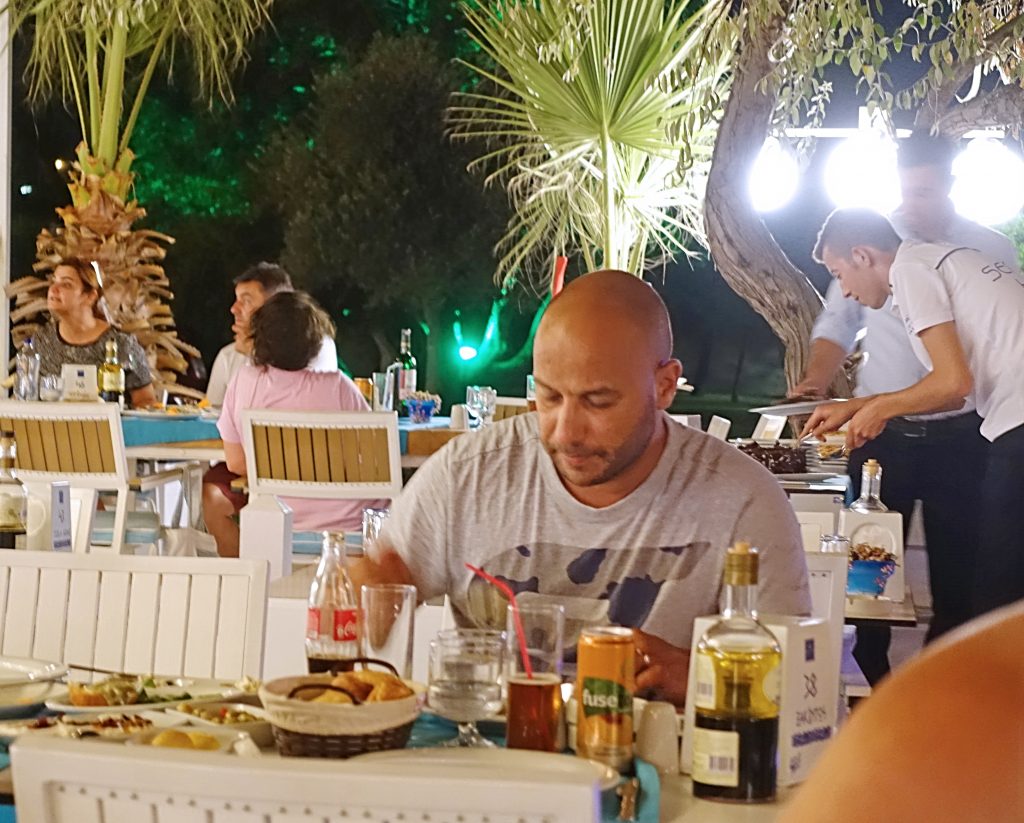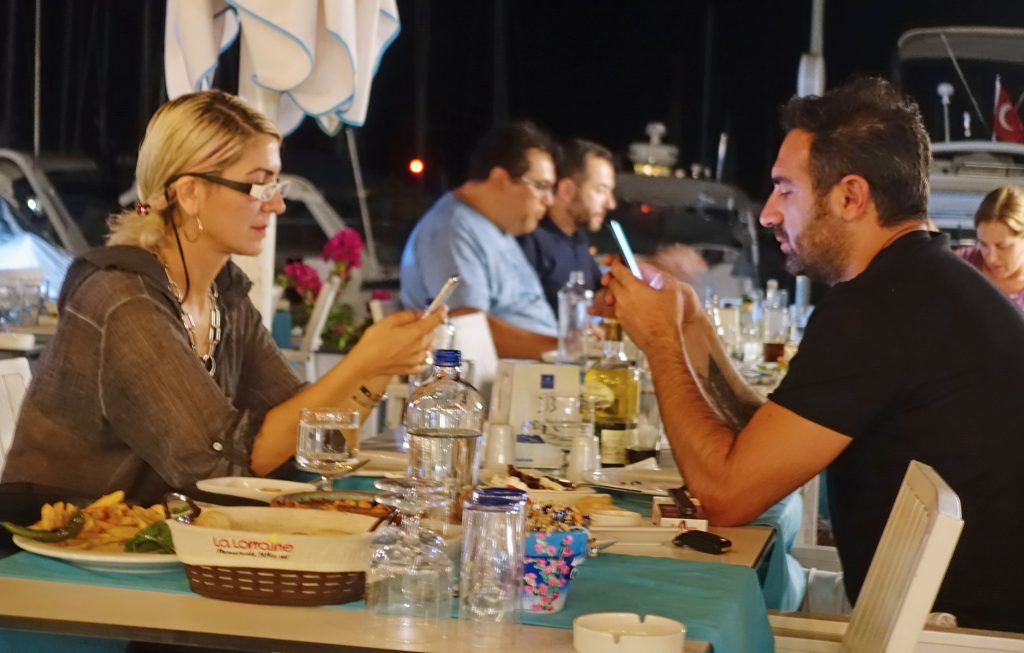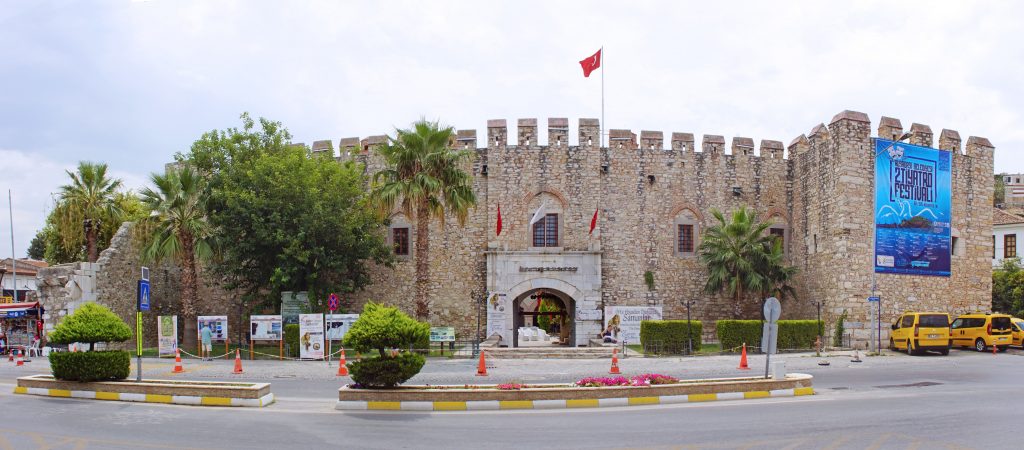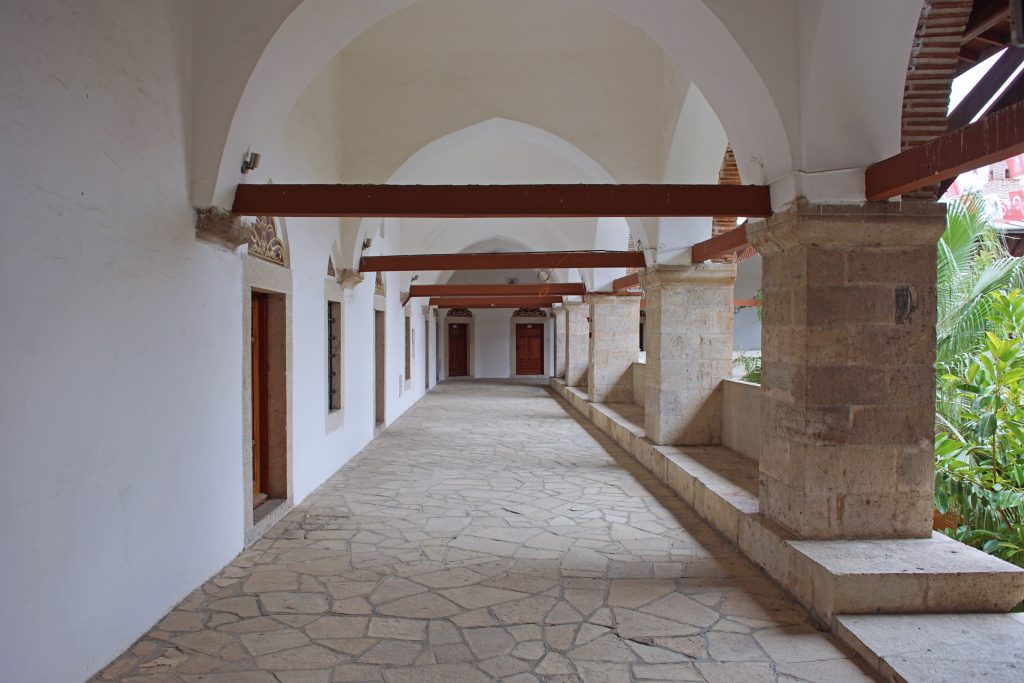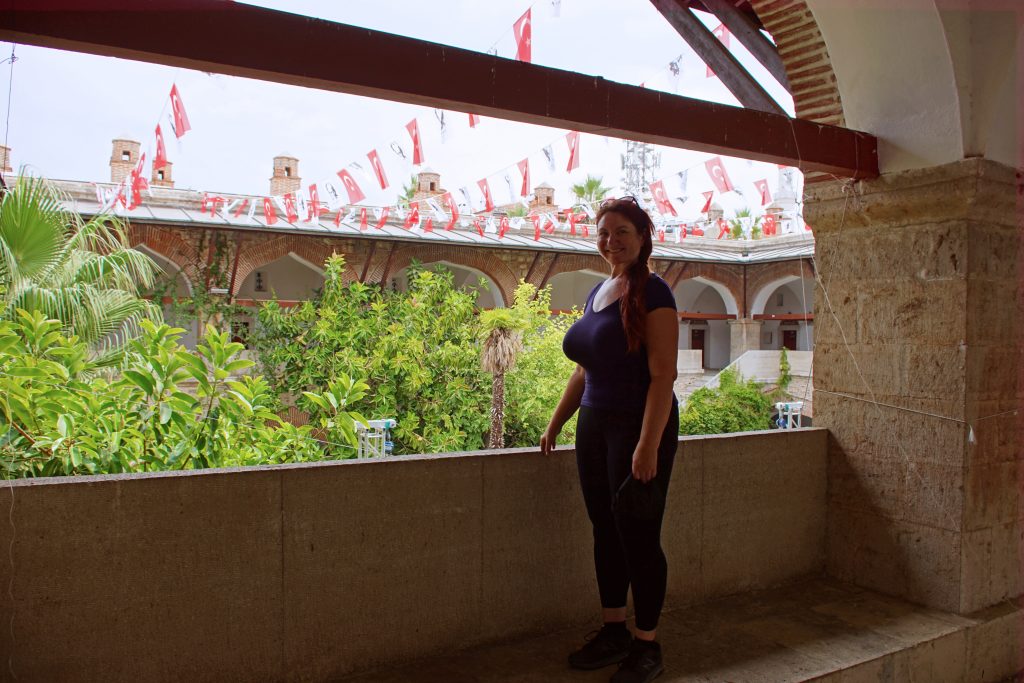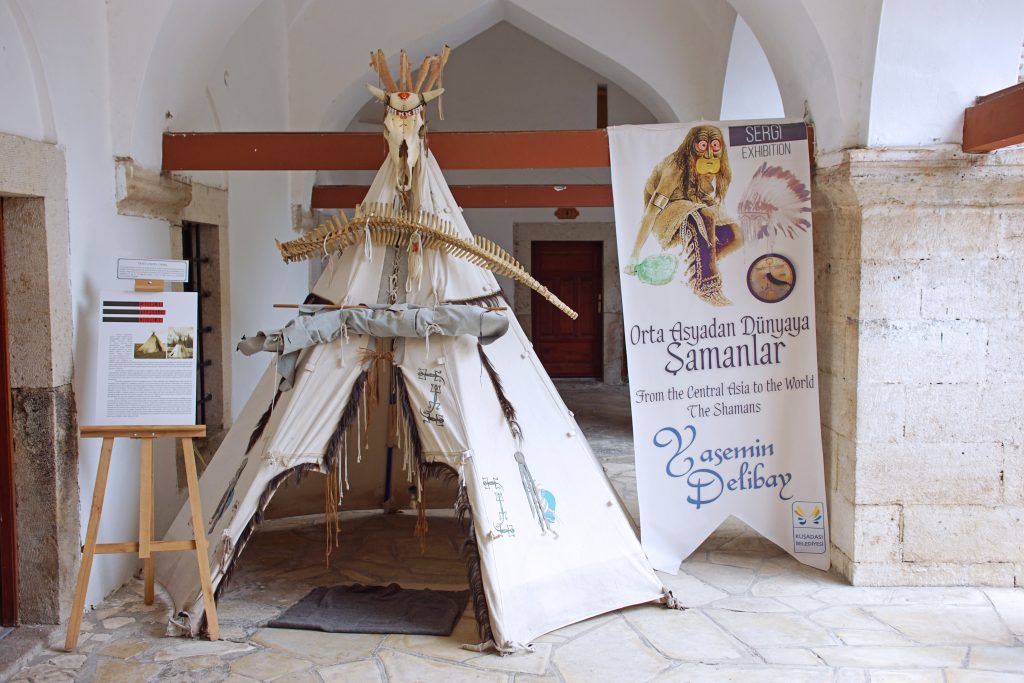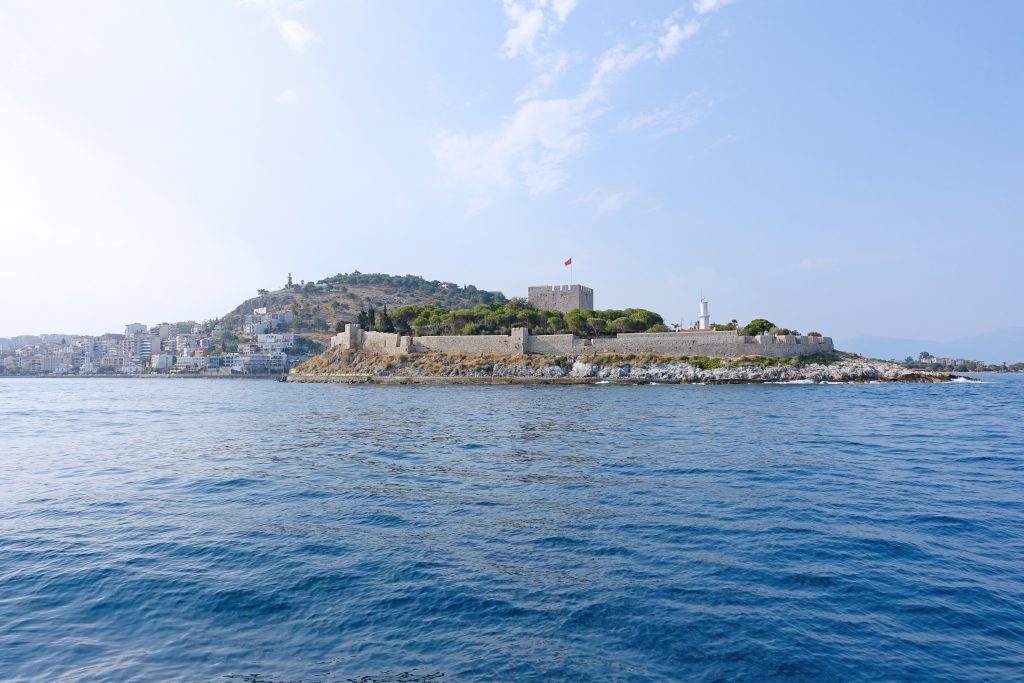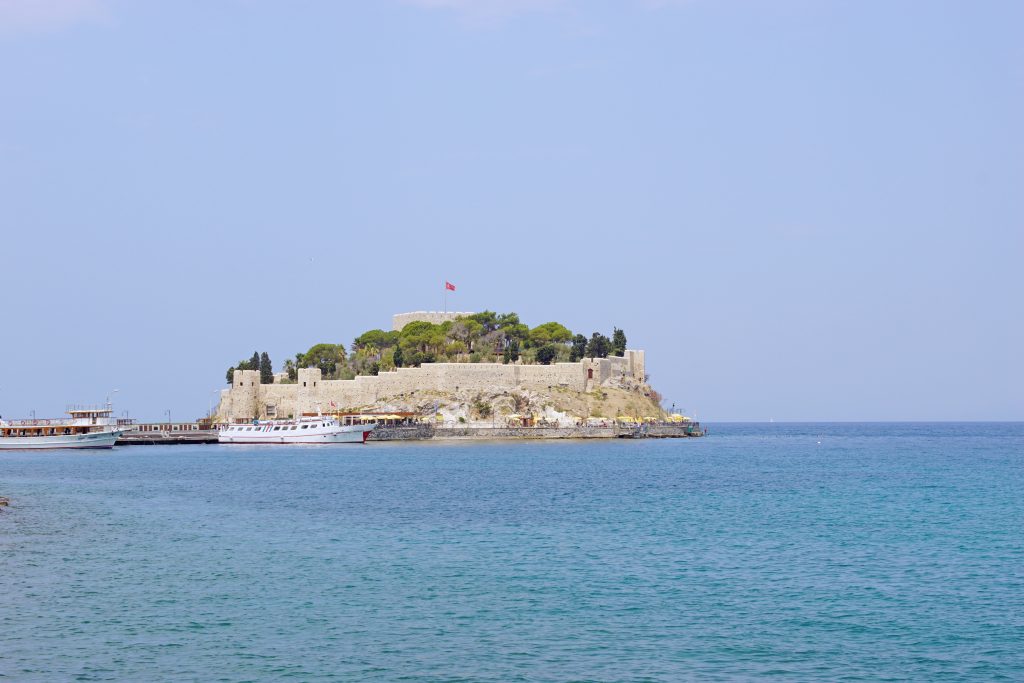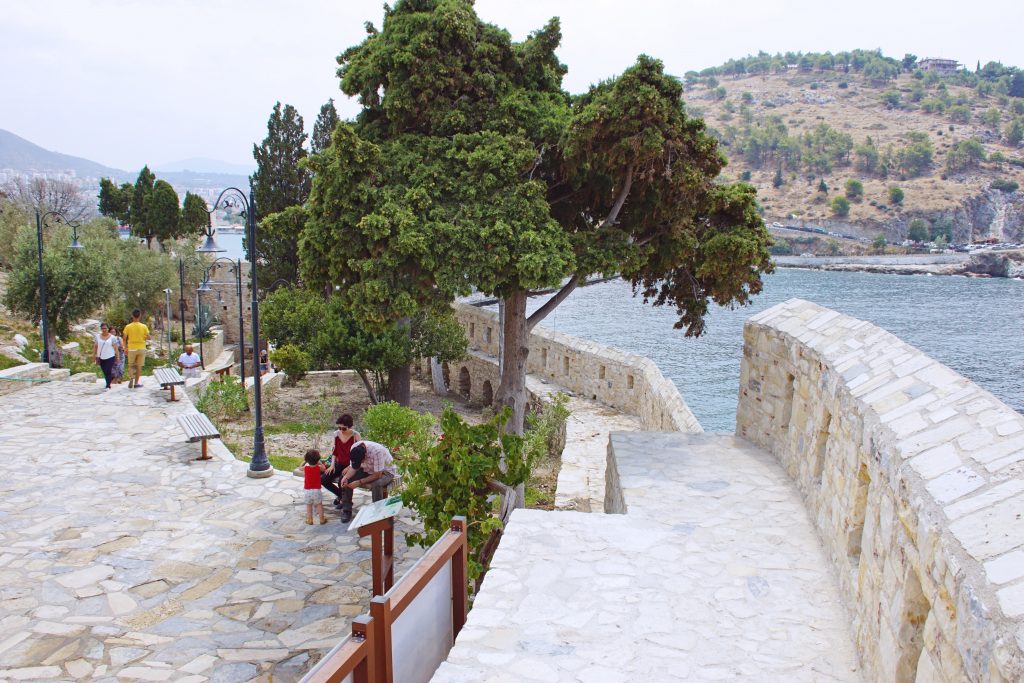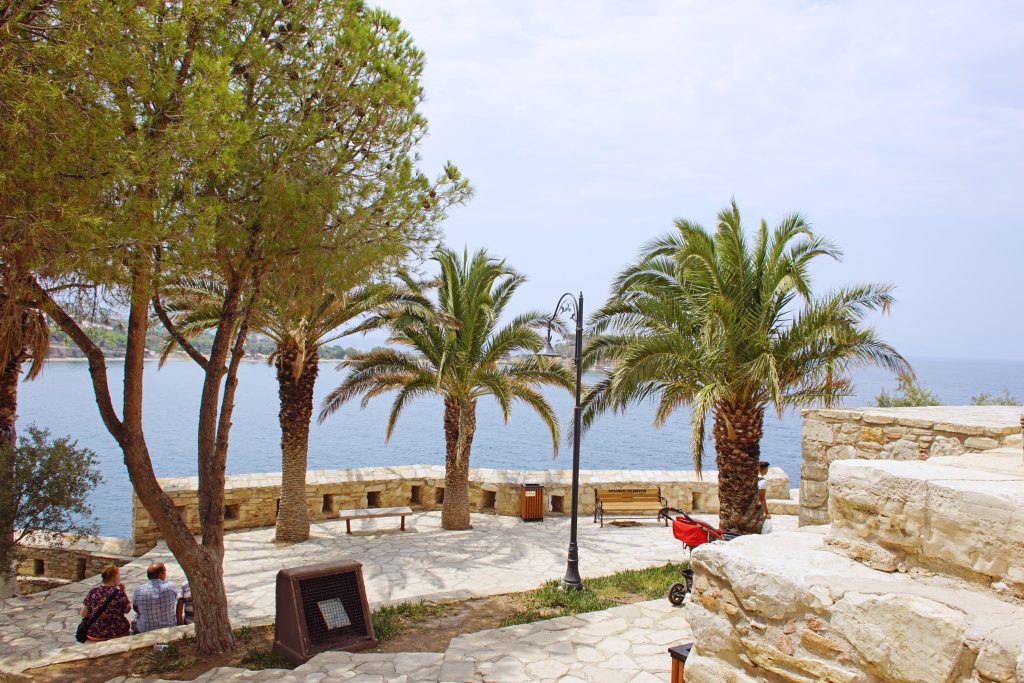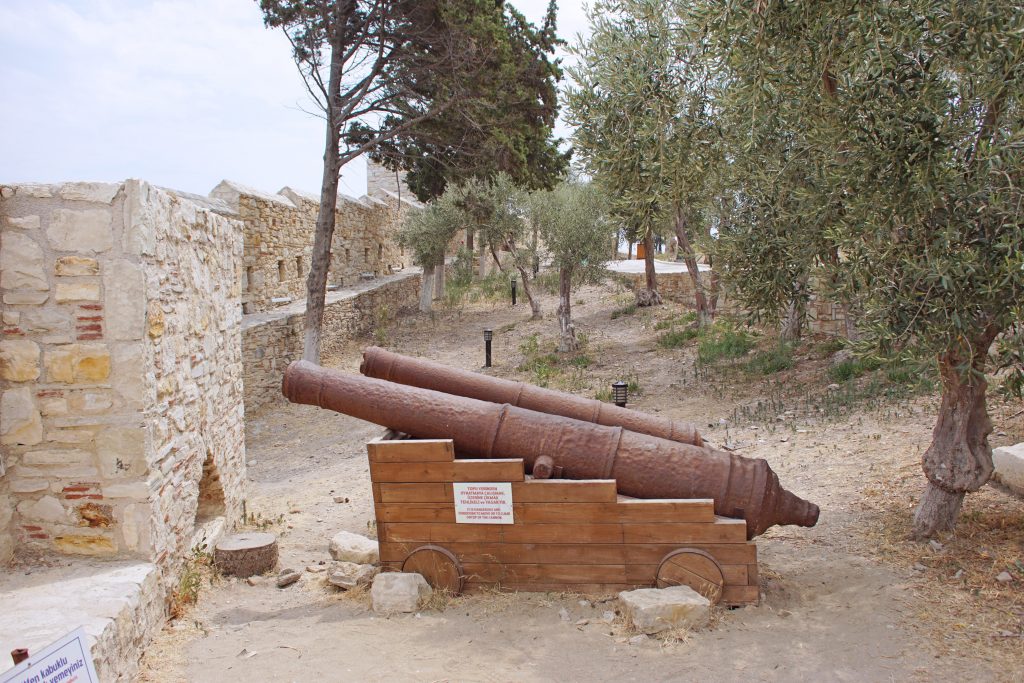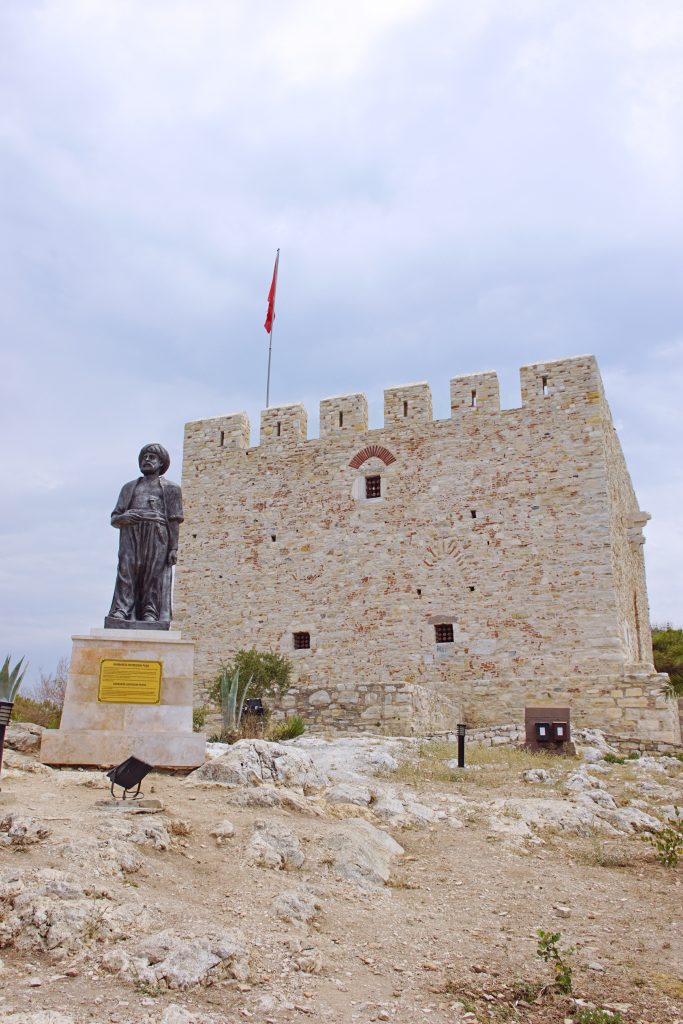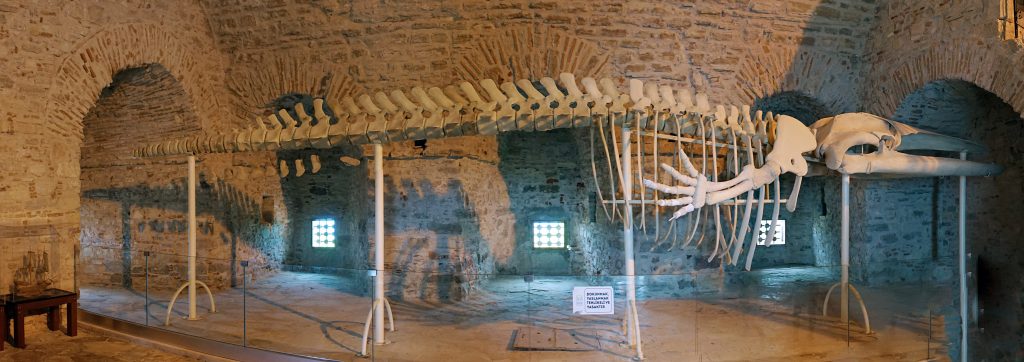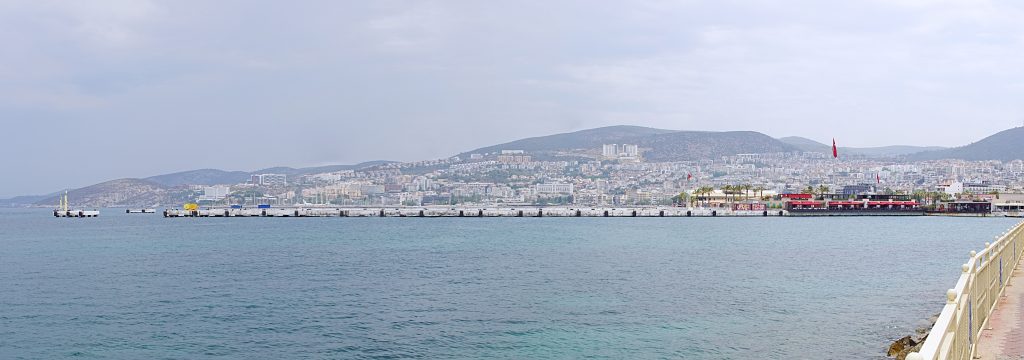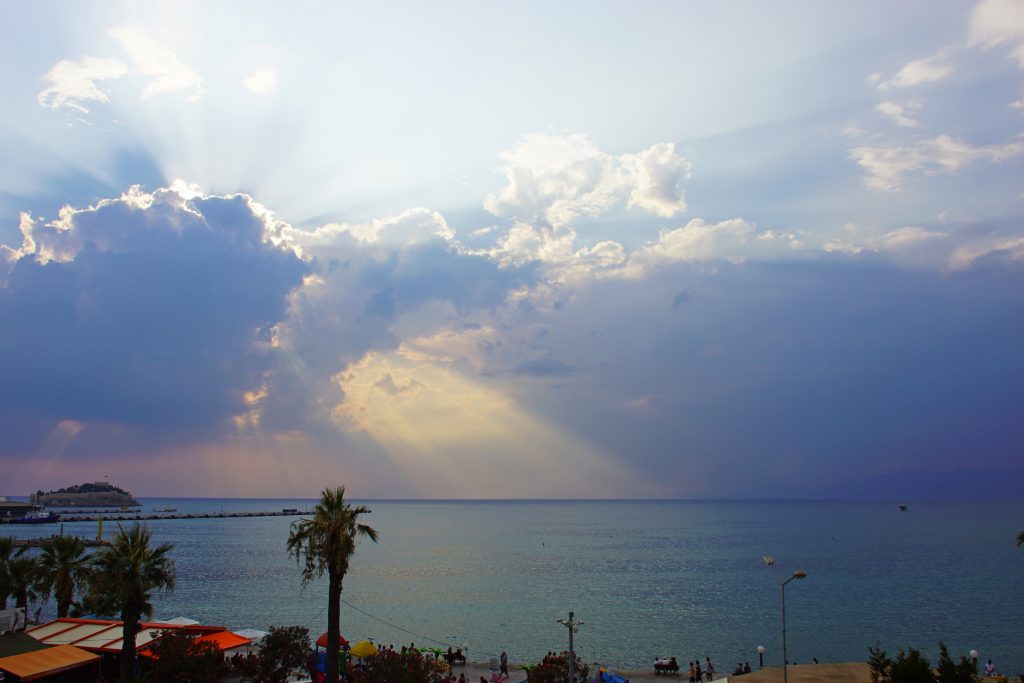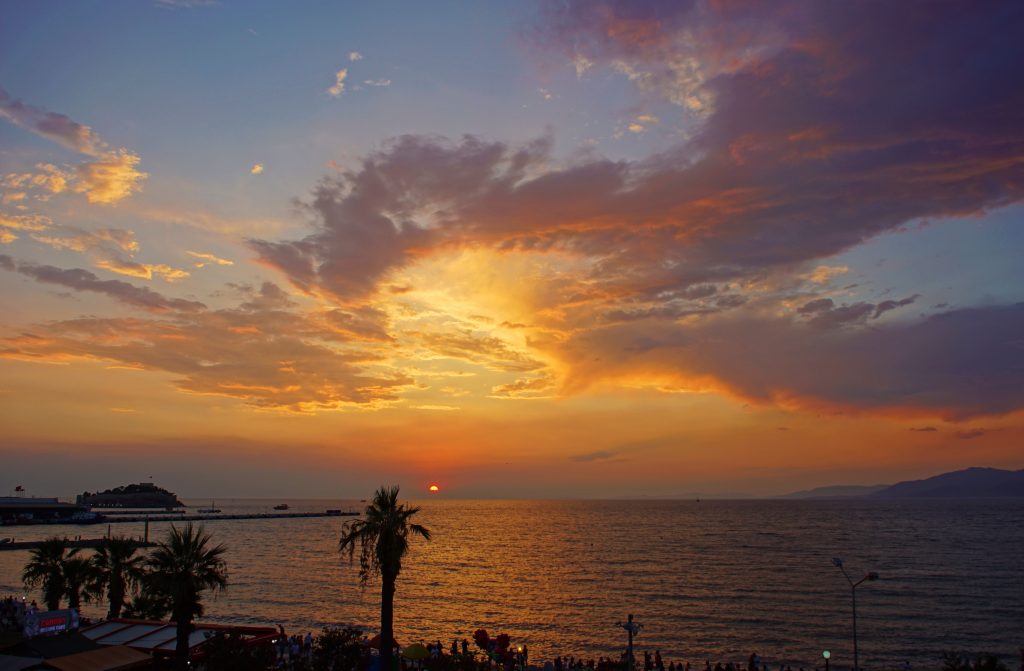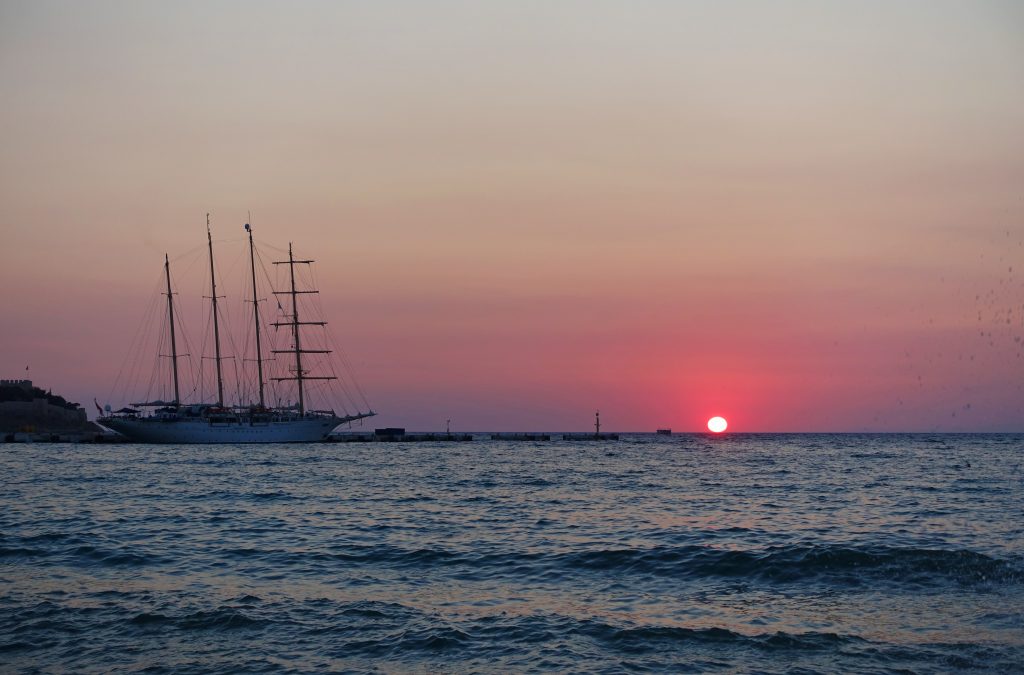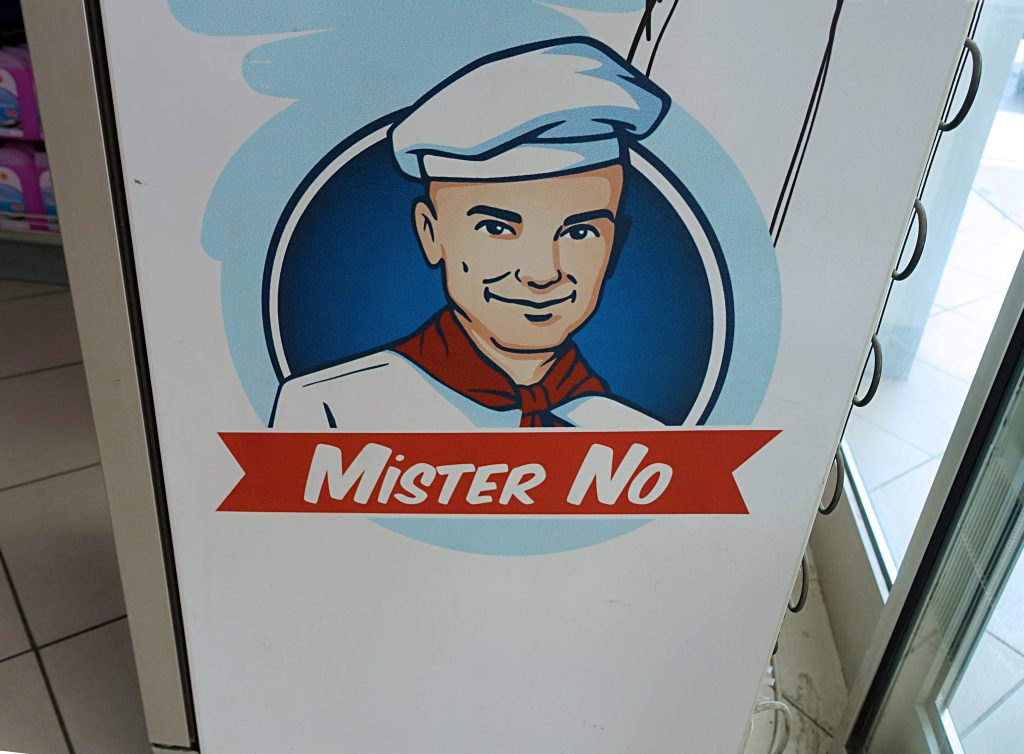The backstory: We were vacationing in Greece on the island of Samos to celebrate our 10th wedding anniversary. We could see Turkey from our balcony and watched the sun rise over the beautiful country every morning. We wondered if it is possible for us as American citizens to cross the border, even if just for a day.
Since we’ve had experience island hopping, we understood that we would need to go to a Port in order to get any meaningful information on how to travel to nearby areas. So, we drove to the city of Samos (Σάμος) to see what we could arrange. We visited the offices of Samos Travel Services and spoke to a VERY helpful woman named Iakovina (first letter is i, not L).
She told us that the ferry left Samos each morning and returned each afternoon for the town of Kuşadası (koo-sha-dah-see), and we could stay more than a day if we wanted. We realized that we could actually celebrate our anniversary in Turkey. Well, why not? Let’s make it a three-day trip!
Iakovina helped us select the best times to catch the ferry each way, explained that we’d need a Turkish Visa and how to get one online, and arranged for a private car to pick us up near our apartment in Kokkari and drive us to the dock early in the morning. Iakovina also told us how to arrange for our return trip once we arrived in Turkey. And, since we didn’t have a printer, we were able to email our visas to their offices so they could print them for us.
See? I told you she was helpful!
And this is part 1 of our story… 😎
Kuşadası
As you probably know, Kuşadası has been a center of art and culture since some of the earliest recorded history, and has been settled by many civilizations since being founded by the Leleges people in 3000 BC. Later settlers include the Aeolians in the 11th century BC and Ionians in the 9th. Originally, seamen and traders built a number of settlements along the coastline, including Neopolis.
But that’s all ancient history. We are here to enjoy the fun and adventure of this seaside resort, so let’s go see what there is to see.
Linguist, take note: the ş in Kuşadası is pronounced SH as in sharp or bash, and the final letter in the name is a dotless i, pronounced ER as in water.
PC Police, take note: It is trendy in America these days to refer to Orientals as Asians. However, when one is in Asia, but not the Orient (East Asia) that distinction is lost.
Not to be confused with La Boca, the neighborhood of Tepe has 400 houses painted in bright colors simply to be pretty. We wonder if the residents of the houses had to all agree to the painting, or if they woke up one morning and said, “Ne sikim, ahbap!”
Bird Island Municipal Park Güvercinli is a quiet little park along the sea in the tourist area, with a walking path, a few benches, fountains, restaurants and, of course, pigeons or doves, which is not surprising because Güvercin means pigeon or dove in Turkish.
Güvercinli park welcomes us with doves showing the biblical reference of the olive branch. Or, perhaps they are pigeons, a reference to Güvercinada? We don’t know, but we will have more on Güvercinada later. 😛
Ismail Cem was a Turkish Minister of Culture who helped strengthen the relationship between Turkey and Greece. Hence, the doves.
At the far end of the Peace and Friendship attraction is the Hand of Piece, a tribute to both Thing and to doves.
Somehow the pigeons know that this statue belongs to them.
Here we learn about Mustafa Bülent Ecevit, a prominent and respected Turkish citizen. In case you are asked, Mr. Ecevit served as the Prime Minister of Turkey four times between 1974 and 2002. He was the leader of the Republican People’s Party (CHP) between 1972 and 1980, and in 1989 he became the leader of the Democratic Left Party (DSP). He translated works by Rabindranath Tagore and T. S. Eliot into Turkish. Ecevit, who studied at Robert College, one of the most prestigious high schools in Istanbul, was successful in these literary endeavors despite never having graduated from a university, a fact that also prevented him from ever running for the Presidency of the Turkish Republic.
Mehmed Pasha was an Ottoman statesman and military commander of the early 17th century who held the office of Grand Vizier twice. He was also governor of Egypt from 1607 to 1611. He married princess Gevherhan Sultan, the daughter of sultan Ahmed I and Kösem Sultan. He had to misfortune to be strangled to death in office in 1619 by a young Janissary.
The Yurtta Sulh, Cihanda Sulh monument is a wonderful place to take a photograph of your best girl’s best features. Maybe we should do that, too!
Kuşadası is a coastal town so, whatever the weather is, wait a while and it will change. Smile!
Built in 1618 by Mehmed Pasha (see above), Kaleiçi Cami is said to be oldest and most beautiful mosque in the city. It was closed when we tried to visit it, so we will never know. 😥
Shopping
Nazar Boncuk wards off the evil eye. Based on the number of amulets found here, we are not sure this is a safe place to shop! Note: we did buy one and it’s hanging in our living room. 😎
We visit the Orient bazaar, a bizarre place that is geared to the tourists who pour off the cruise ships, spend money, then disappear forever. We see many male shopkeepers (never any female shopkeepers) in front of their shops, inviting us to purchase their products. Although is seems impolite, it is best not to engage them. They are very friendly, but their only objective is to pressure you into buying their products.
Plus, we Californians do not understand the art of bargaining.
Shopkeeper: Sir! Leather jackets, 100 euros. I do not respond. Shopkeeper: 80 euros.
Okay, I know this is how they do business, but my first thought is, “If you misrepresented the price, why should I believe you about the quality of your jackets?” See? We don’t understand the art of bargaining.
This place advertises sunglasses as “genuine fake watches.” We are afraid to look inside. 🙄
There are many areas of the old city that are (to our minds) more conventional shopping areas, where we can stroll and relax. Since these shops are for tourists, they sell the same things and we soon cannot tell one street from the next.
Since we are in Turkey, we are making an effort to dress conservatively. With just a few additions, we could have a complete hajib.
We purchase a few gifts for our friends, but this is what we purchase for ourselves: a two-tile scene of a Turkish bath. We found it at Hacivat Shop, an establishment highly ranked by TripAdvisor. There are no high-pressure salesmen and there is no bargaining. Each piece of ceramic is hand-made and hand-painted and each is slightly different from the next.
The salesman explains that the baths would be men-only one day, women-only another day, one day only for workers, etc. In this scene, there are the owners, a gypsy playing a musical instrument, a hookah, a worker providing the hookah tools, and many nude bathers, who would have been the guests of the owners. Two tiles represent infinity, because tiles can be added to the story ahead or behind. He also tells us how it’s harder to display this kind of art farther east in Turkey: “their minds, they are closed!” We love this piece and it seems the perfect anniversary gift to ourselves. When we tell them that it is our 10 year anniversary, they speak very fast among themselves, then present us a gift: a blue evil eye. “You hang it in your home and you will always be happy”.
Dining
There are many, many foods included in “Turkish cuisine,” but it’s as descriptive as “American cuisine”: Are you talking about hotdogs, pork chops, or vegan meatballs? So, basically, we don’t worry about it.
Everywhere we’ve traveled in the world has chocolate. We don’t know why there are so many babies involved. If you look closely just beyond the gold boxes, you can see more little babies. Are we supposed to eat them?
There are vendors selling muscles, and we watch locals eat them messily. We do not partake. Seafood exposed in the sun, being sold by “some guy”, does not seem a safe food to eat. Sorry.
Sadly, our hotel room does not have a kitchen, so we are unable to experience foods from the local butcher. Well, maybe next time.
I gladly admit my bias towards not eating food with faces and eyes. Although lamb’s head is probably delicious when prepared by a Turkish cook, we shall stick to less heady food, thank you very much.
While the Mado restaurant might serve delicious food, DO NOT ASK TO BE SEATED OUTDOORS!
If you don’t want to eat Turkish food, you can always go for Asian food, because, wait, Turkish food IS Asian food, because Turkey is part of Asia. See? Let’s just agree to call it Oriental food. Wait. There is Indian food, too. Goddamit.
American-style fast-food is everywhere. Of course, we do not eat it. Why go to Turkey to eat food that tastes like cardboard, amirite?
Okay, let’s get down to the real food of Turkey: baklava.
There is Fistikli Özel Kare Baklava, Kaymakli Fistikli Burma Kadayif, Havuç Dilim, Fistikli Baklava, Cevizla Baklava, and Fistikli Tel Kadayif, all made by the wonderful folks at Faruk Güllüoğlu. Yummy.
The Port
Our favorite restaurant in Kuşadası is The Port. We like it because it is air conditioned, they serve all sorts of delicious food, and it is always empty because it is illegal to smoke cigarettes indoors in public places in Turkey and EVERYBODY smokes in Turkey and so smokers have to eat outdoors. Sweet.
Oh, and did we mention? It’s a chocolate cafe. 😛
But serving chocolate does not preclude serving beer, and there’s (almost) nothing better than a cold beer on a hot day in Turkey.
We are always surprised that anyone in the world eats mayonaise, and even more so that we find it in Turkey. Mayonnaise is a lot of oil with a little albumen (i.e., egg white), plus a bit of acid such as lemon juice. But mostly oil. Oil. NOT what I want to put on my food, thank you very much.
We order a plate of Kanafeh. It is very sweet and covered with crushed pistachio nuts. Yum.
There is nothing like a glass of rich red wine and delicious confectionery chocolate.
There is nothing like delicious confectionery chocolate and a glass of rich red wine.
Okay, now it’s getting ridiculous. If we don’t stop this, we are going to have to pay a weight penalty on the boat back to Samos.
She looks happy, right? There is a reason for that. 😎
Ayvalik Balikçisi
On the day of our tenth wedding anniversary, we decide to go to Ayvalik Balikçisi, a seafood restaurant near the sea. We get there early to avoid the (other) tourists.
The staff shows us a table, then immediately takes us to an assortment of food in dishes on shelves of a wall, and indicates to us to pick what we want. It’s difficult because we don’t know what the labels on each dish mean, so we select food we recognize. We return to our table for bread, olives, a few appetizers, and a blue container (in the middle of the table) that is a mystery.
We aren’t sure what all the food is, but we taste it and find it to be delicious. We eat slowly, pacing ourselves for the main course.
In just a short while, the main course arrives. As usual, we order only one meal and split it, because that’s always enough. Even so, this is more than we can eat.
As we are finishing, to our surprise, the staff brings to us a large plate containing the various catches-of-the-day so we can select one for our main course. We politely decline. The second course of this apparently three-course meal was rich enough and filling enough. We are satisfied.
A number of times during the evening, the staff carries a sparkling cake to a diner while singing a Happy Birthday song.
You can’t tell, but by this time of the evening, pretty much anyone over the age of six is smoking. As an act of politeness, they hold their burning cigarettes behind them so the folks at their own table are spared the fumes…which is strange, because they all are smoking. Because of this, the people directly behind them (us) enjoy the effluvia instead.
The moral of the story is this: When you are in Turkey, you are going to smoke.
It appears that Mark Sinclair has joined us for the evening. We respect his privacy and do not ask for an autograph.
We like to believe they are madly in love and too embarrassed to express their mad lust in public, so they text the words of desire to each other: “Seni İspanya’da küçük bir maymun gibi sürmek istiyorum.” Of course, it may be lost in translation, but you get the idea.
Club Kervansaray
Near the Orient Bazaar in Kuşadası is an imposing fortress. At least, that’s what we thought.
In fact, this is the Öküz Mehmet Paşa Kervansarayı (see above for information on Mehmed Pasha). The caravanserai was constructed in the early 1600s and is now a hotel, Club Kervansaray Kuşadası. Let’s go inside.
The hotel seems to be deserted; there is no one but us. Perhaps they are out visiting the bazaar or smoking at a restaurant?
The courtyard is lush with Mediterranean vegetation and topped with flags of the Motherland. We find the red and green contrast appealing.
We cannot figure out what is happening here. An owl-eyed image of a shaman is posed in an uncomfortable positions, with an American Indian war bonnet beside him and an image on the tent of Kokopelli, a fertility deity, drawn in a commercialized form. We are so confused.
Güvercinada
Güvercinada (literally: Pigeon Island, as it once was an island) is a peninsula connected to the mainland by a narrow, man-made causeway 350 meters in length.
The castle was built in the 1500s during Turkey’s Ottoman era. The castle walls, 3 meters in height, surround the island completely, and were built in order to prevent an attack from the islands during the Greek Orlov Revolt of 1770.
The castle has a beautiful symmetry. We admire its beauty against the blue waters and blue sky.
The courtyard of Güvercinada, designed for battle, is now a resting place for weary travelers.
There are few other tourists here, and we sit for a while to enjoy the gentle sea breeze.
There are a few old artifacts of ancient times, such as these cannon barrels. We adhere to the regulations and do not move the 10-ton cannons.
The original castle was commissioned by Barbaros Hayreddin Pasha, an Ottoman admiral of the fleet whose naval victories secured Ottoman dominance over the Mediterranean during the mid-16th century, from the Battle of Preveza in 1538 until the Battle of Lepanto in 1571.
Güvercinada has a small museum containing a life-size whale skeleton. The sign warns us that it is very old, so it’s possible that it is indeed a skeleton and not a replica.
Out and About
There are many beautiful, panoramic views around Kuşadası.
For some reason, all cities seem to have one or two ugly buildings in the background. But if you ignore these, you’ll see a very Mediterranean seaside town with shops (in red), palm trees, and the masts of sailboats.
Similar to many beaches we’ve seen in the Mediterranean, beach umbrellas are lined up to allow people to sit closely together (for some reason). Contrary to many beaches we’ve seen in the Mediterranean, no one is topless or in a thong, and many folks are wearing street clothes.
The countryside is classical Mediterranean, with rolling hills, green valleys, red tile-roofed houses, and olive orchards.
As we drive from Kuşadası to İzmir, we are surprised at the abundance of high-end resorts. There are restaurants overlooking the sea, private beaches, and even private sunning areas on platforms over the water.
Sunrise, Sunset
We always appreciate a sunrise and sunset, and Kuşadası is no exception.
The first night we are here, we capture the sun about an hour before setting, shining heavenly beams on the distant waters.
We watch as the sun turns many shades of yellow and orange, coloring the clouds with fabulous colors.
We imagine that, in centuries past, sailors around the worlds enjoyed just such a sight each night, wondering where their further adventures would take them.
On the left is a photograph we took a few days earlier in Samos, Greece, with the sun rising over Turkey. On the right is a photograph we took in Turkey of the sun setting over Samos, Greece. It’s all one big, beautiful world, isn’t it? 🙂
Mister No
No, not Dr. No; Mister No.
We first encounter Mister No on the side of a small cooler in a shop. “What are they tellilng us to avoid?” But, no. Mister No is not about no-thing, but is instead an advertisement for a comic book called, “Mister No.” And that’s all we know.

